
About UsThe Numismatic Bibliomania Society is a non-profit organization devoted to the study and enjoyment of numismatic literature. For more information please see our web site at coinbooks.org SubscriptionsThose wishing to become new E-Sylum subscribers (or wishing to Unsubscribe) can go to the following web page link MembershipThere is a membership application available on the web site Membership Application To join, print the application and return it with your check to the address printed on the application. Membership is only $20 to addresses in the U.S., $25 for First Class mail, and $30 elsewhere. For those without web access, write to: David M. Sundman, Treasurer AsylumFor Asylum mailing address changes and other membership questions, contact David at this email address: dsundman@LittletonCoin.com SubmissionsTo submit items for publication in The E-Sylum, just Reply to this message, or write to the Editor at this address: whomren@gmail.com BUY THE BOOK BEFORE THE COIN |
- WAYNE'S WORDS: THE E-SYLUM APRIL 19, 2015
- LAKE BOOKS SALE #121 PRICES REALIZED AVAILABLE
- KOLBE & FANNING SALE CLOSES APRIL 25, 2015
- NEW BOOK: PRICES REALIZED FOR BUST HALF DOLLARS 1794-1839
- NEW BOOK: TYPE THREE DOUBLE EAGLES, 2ND EDITION
- NEW BOOK: I MURDERED MY LIBRARY
- THE MCA ADVISORY CIRCUS ISSUE
- CONECA PUBLISHES THE MAY/JUNE 2015 ERRORSCOPE
- CATALOG REVIEW: D. BRENT POGUE COLLECTION, PART I
- COURT ISSUES RULING ON CONFISCATED 1933 DOUBLE EAGLES
- NOTES FROM E-SYLUM READERS: APRIL 19, 2015
- SMITHSONIAN DIGITIZING 250,000 BEP PROOFS
- THE EARLIEST U.S MINT PURCHASE OF ALUMINUM?
- THE HIGLEY KING AND THE PERILS OF OVER-SPECIALIZATION
- HELP SOUGHT FOR CENSUS OF CASTORLAND JETONS
- THE MYTH OF APPOMATTOX
- VICTOR DAVID BRENNER’S LINCOLN PLASTER
- SOME INTERESTING MEDALS: APRIL 19, 2015
- HENNING COUNTERFEIT NICKELS SOUGHT IN RIVER
- CNG AUCTION 99 CLOSES MAY 13, 2015
- HERITAGE APRIL 2015 CICF AUCTION RECAP
- GIBRALTAR’S 1994 THREE GARRIDEBS CROWNS
- DOOLITTLE TOKYO RAIDERS CONGRESSIONAL GOLD MEDAL
- WAYNE'S NUMISMATIC DIARY: APRIL 19, 2015
- DESIGNER JODY CLARK STRIKES FIRST NEW PORTRAIT COINS
- DENMARK’S MARGRETHE II ON COINAGE
- WHICH COUNTRY HAS THE LEAST SEXIST BANKNOTES?
- HOW JANE AUSTEN GOT ON TO £10 NOTES
- DICK JOHNSON'S TAKE ON WOMEN ON MONEY
- THE PHANTOM SILVER DOLLARS OF 1895
- THE RAND BROTHERS, BANK ROBBERS
- SS CITY OF CAIRO COIN TREASURE SALVAGED
- WAS RUSSIAN WWII BULLION LOST IN RIVER?
- PUNIC EMPIRE COIN AMONG OLDEST DISCOVERED IN BRITAIN
- A HOARD FOUND IN POLAND
- COCOS ISLAND TREASURE A HOAX
- MEDIOCRITY AND GREATNESS IN NUMISMATICS
- FEATURED WEB PAGE: MARK R. SHENKMAN COLLECTION
Click here to access the complete archive
To comment or submit articles, reply to whomren@gmail.com
WAYNE'S WORDS: THE E-SYLUM APRIL 19, 2015

New subscribers this week include: Emil Eusanio and Mark Hotz. Welcome aboard! We now have 1,847 subscribers.
This week we open with updates from literature dealers Lake and Kolbe & Fanning, three new books, two new periodicals, and a review of the Pogue sale catalog.
Other topics include the Langbord 1933 Double Eagles, 1895 dollars, a BEP digitization project, Castorland jetons, Brenner's Lincoln cent plaster, Henning's counterfeit nickels, and Gibraltar's Three Garridebs crowns.
To learn more about the Casa de Moneda de Lima, the Ricketts's Circus Token, the Higley King, the Myth of Appomattox, the Diana ashtray, Brazilian gold ingots, the Castle Garden token, and mediocrity and greatness in numismatics, read on. Have a great week, everyone!
Wayne Homren
Editor, The E-Sylum
LAKE BOOKS SALE #121 PRICES REALIZED AVAILABLE
The prices realized list for our sale #121 which closed on Tuesday, April 14, 2015 is now posted on our web site at http://www.lakebooks.com/current.html. The sale featured the libraries of Bill Panitch and Warren Tucker and was quite strong in a number of areas including ANS early material, early Redbooks, plus tokens and medals. Our next sale will be held on July 14, 2015 and will feature the library from the estate of Rusty Schroeder.
Lake Books
6822 22nd Ave N
St. Petersburg, FL 33710-3918
727-343-8055 fax: 727-381-6822
KOLBE & FANNING SALE CLOSES APRIL 25, 2015


Casa de Moneda de Lima document; Tentzel
Kolbe & Fanning Numismatic Booksellers wish to remind clients that their April 25 mail-bid and live online sale has been posted, and that bidders may browse the sale’s contents through the firm’s online bidding portal at auction.numislit.com.
The second in a new series of smaller mail-bid and online numismatic book auctions, the April 25 sale focuses on numismatic literature dealing with ancient and foreign coins, and features 376 lots ranging in estimated value from $15 to $800. All lots are illustrated.
Some sale highlights include:
Lot 27: Biaggi’s massive work on Piedmont
Lot 38: a long run of The Medal
Lot 99: Forrer’s Biographical Dictionary of Medallists
Lot 115: the complete Lockett sales, bound in two volumes
Lot 194: original documents from the Casa de Moneda de Lima
Lot 268: Robinson’s Excavation at Olynthus III: Coins Found at Olynthus in 1928
Lot 331: a set of all six fascicles of the SNG Tübingen
Lot 344: an original set of Tentzel’s 1713 Saxonia Numismatica.
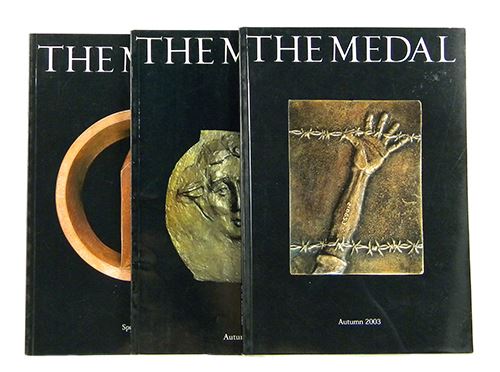
The online sale is available now for browsing and absentee bidding at auction.numislit.com. A PDF of the catalogue can be downloaded for the convenience of the reader through the firm’s regular website at www.numislit.com. While bidders are encouraged to bid through the online platform, bids may be submitted through the traditional methods as long as any such absentee bids are received by Kolbe & Fanning by the day before the sale. Absentee bids may be placed directly online at any time prior to the lot being sold. On Saturday, April 25, beginning at noon eastern time, the sale will be conducted as a live internet auction.
Customers who have participated online in any of Kolbe & Fanning’s recent sales will be familiar with the process. Others are encouraged to set up an iCollector account through auction.numislit.com and see for themselves how easy it is. Bidders wishing to participate in the live sale are strongly encouraged to register in advance.
Any questions may be directed to David Fanning at df@numislit.com or by phone at (614) 414-0855. We look forward to your participation.
NEW BOOK: PRICES REALIZED FOR BUST HALF DOLLARS 1794-1839
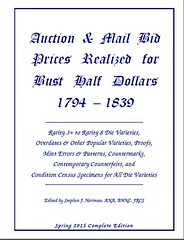
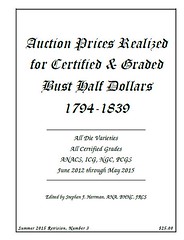
Available Now - Complete Edition of Auction & Mail Bid Prices Realized for Bust Half Dollars 1794-1839 (Spring 2015 revision)
Distributed as a searchable PDF format file on CD-ROM. The Complete Edition of the AMBPR includes two complete, sorted and formatted listings of the more than 51,700 records in the AMBPR database.
R3+ to R8 die varieties, overdates & other popular varieties, proofs, mint errors & patterns, countermarks, contemporary counterfeits, and condition census specimens are listed for most major auctions held since 1984!
-- Full listing in order by Die Variety Number
-- Full listing in order by Sale & Lot Number
Distributed via CD-ROM, 1,782 pages, $50.00 postpaid. $5.00 shall be donated to the JRCS for each copy sold. Please contact Steve at Herrman102(at)aol.com
Note: This is a once in every 5 years publication. Requires Adobe Reader for Windows OS or Mac OS.
Available Soon - Auction Prices Realized for Certified & Graded Bust Half Dollars 1794-1839 (Summer 2015 revision)
Distributed as a softbound copy or in PDF file format, the APRCG contains a listing of all certified and graded Bust half dollars sold in major auctions during the last three years (June 2012 through May 2015).
Softbound copy is $25.00 postpaid. Softbound copy plus PDF file is $30.00 postpaid. PDF file by itself is $20.00. Regular subscribers and pre-orders (prior to June 6) shall receive a $3.00 discount. $1.00 shall be donated to both the BHNC and the JRCS for each copy sold.
Please contact Steve at Herrman102(at)aol.com
Note: This is an annual publication. PDF file requires Adobe Reader for Windows OS or Mac OS
Steve adds:
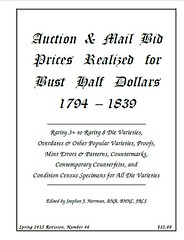 Not described in the latest JR Newsletter is my primary publication, Auction & Mail Bid Prices for Bust
Half Dollars 1794-1839. It has been published every Spring and Autumn starting in September 1992.
Not described in the latest JR Newsletter is my primary publication, Auction & Mail Bid Prices for Bust
Half Dollars 1794-1839. It has been published every Spring and Autumn starting in September 1992.
The Spring 2015 revision is number 46. Distributed as a softbound copy, 264 pages, $32.00 postpaid. It is also available in PDF format. $2.50 is donated to the John Reich Collectors Society for each copy sold.
To read the complete article, see:
JR Newsletter: 12 April 2015 (236)
(http://jr-newsletter.blogspot.com/2015/04/jr-newsletter-12-april-2015-236.html)
NEW BOOK: TYPE THREE DOUBLE EAGLES, 2ND EDITION
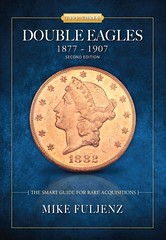 An important new reference book about a popular United States gold coins series, Type Three
Double Eagles 1877 - 1907 (Second Edition), provides beginning and advanced collectors a date-by-date analysis of every coin in the
series, historical vignettes and more than 100 full-color photographs. The book was written by Michael Fuljenz, President of Universal Coin
& Bullion Ltd. in Beaumont, Texas.
An important new reference book about a popular United States gold coins series, Type Three
Double Eagles 1877 - 1907 (Second Edition), provides beginning and advanced collectors a date-by-date analysis of every coin in the
series, historical vignettes and more than 100 full-color photographs. The book was written by Michael Fuljenz, President of Universal Coin
& Bullion Ltd. in Beaumont, Texas.
Fuljenz predicts that last year's wide-spread publicity about the discovery of the Saddle Ridge Hoard "should increase collector and investor interest in this (Type Three Liberty Head Double Eagles) series for a long time." The vast majority of the 1,427 gold coins unearthed in the Northern California buried treasure hoard were Type Three Double Eagles.
The new book contains a chart of the Professional Coin Grading Service (PCGS) grades assigned to the hoard coins, and also contains comparisons of PCGS and Numismatic Guaranty Corporation population reports on all Type Three $20 denomination gold coins.
One revealing chapter of the book is described by the author as "the definitive article on the national motto, In God We Trust." It provides proof the inspiration for the motto actually goes back to the War of 1812, pre-dating the 1860s U.S. Civil War era that many believe was the backdrop for the motto.
Fuljenz provides useful collecting, investing, buying and selling tips as well as historical information and price history about this coin series. He includes information about counterfeits and consumer protection, such as the 2014 Collectible Coin Protection Act. Fuljenz assisted the Industry Council For Tangible Assets (ICTA) with lobbying in Washington, DC to get that law approved.
One of the 17 interesting chapters is devoted to "Peter," an eagle that lived at the Philadelphia Mint in the mid 1800s and inspired coin designs as well as bedtime stories.
Type Three Double Eagles were struck at five mints: Carson City, Denver, New Orleans, Philadelphia and San Francisco. Unlike Type One Double Eagles, Type Three have the motto, In God We Trust, and unlike Type Two coins the Type Three have the denomination spelled out as TWENTY DOLLARS rather than TWENTY D.
Other noteworthy features of the book include how President Theodore Roosevelt worked with acclaimed sculptor Augustus Saint-Gaudens on the early 20th century "pet crime" of replacing the design of the Liberty Head Double Eagle and other U.S. coins; Type Three Double Eagles in the National Numismatic Collection at the Smithsonian Institution; celebrity coin collectors; and law enforcement tips on how to protect your coins and other valuables from theft.
Published by Subterfuge Publishing, the suggested price for Type Three Double Eagles 1877 - 1907 is $39.95 including shipping. Copies can be ordered online at www.UniversalCoin.com.
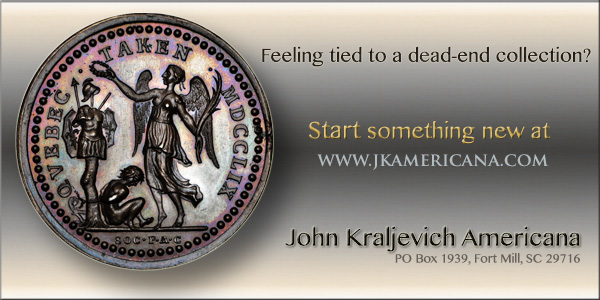
NEW BOOK: I MURDERED MY LIBRARY
Jeff Reichenberger writes:
I just read a very interesting short book from author/bibliophile Linda Grant describing the inner conflict facing many book lovers as they find the necessity to thin out their libraries and simultaneously embrace e-books. Nothing numismatic here but a good read for bibliophiles.
Entitled, "I Murdered My Library", I believe it's only available as a Kindle single. (Naturally, ironically, or appropriately, whichever the case may be.)
 What happens when you begin to build a library in childhood and then find you have too many books? From a
small collection held together by a pair of plaster of Paris horse-head bookends to books piled on stairs, and in front of each other on
shelves, books cease to furnish a room and begin to overwhelm it. At the end of 2013, novelist Linda Grant moved from a rambling maisonette
over four floors to a two bedroom flat with a tiny corridor-shaped study. The trauma of getting rid of thousands of books raises the
question of what purpose personal libraries serve in contemporary life and the seductive lure of the Kindle. Both a memoir of a lifetime of
reading and an insight into how interior décor has banished the bookcase, her account of the emotional struggle of her relationship with
books asks questions about the way we live today.
What happens when you begin to build a library in childhood and then find you have too many books? From a
small collection held together by a pair of plaster of Paris horse-head bookends to books piled on stairs, and in front of each other on
shelves, books cease to furnish a room and begin to overwhelm it. At the end of 2013, novelist Linda Grant moved from a rambling maisonette
over four floors to a two bedroom flat with a tiny corridor-shaped study. The trauma of getting rid of thousands of books raises the
question of what purpose personal libraries serve in contemporary life and the seductive lure of the Kindle. Both a memoir of a lifetime of
reading and an insight into how interior décor has banished the bookcase, her account of the emotional struggle of her relationship with
books asks questions about the way we live today.
To read the complete article, see:
I Murdered My Library (Kindle Single)
[Kindle Edition] (www.amazon.com/Murdered-My-Library-Kindle-Single-ebook/dp/B00K6JO15A/ref=sr_1_1)
THE MCA ADVISORY CIRCUS ISSUE
The March-April issue of The MCA Advisory has gone to press. It contains a definitive article on the Ricketts's Circus Token by Roger Siboni; the author believes this token to have been used for entrance to the shows and thus one can imagine that any given specimen was handled by George Washington or John Adams, both patrons of the Circus. This issue of The Advisory also contains a story on the accession by the P.T. Barnum Museum in Bridgeport, Connecticut, of a gold medal given to Barnum for his work in the Temperance Movement. This truly is our "Circus Issue".

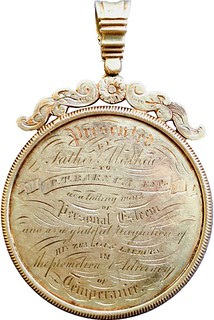
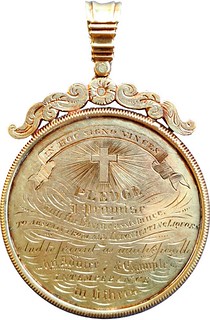
To read the earlier E-Sylum article, see:
RICKETTS'S CIRCUS TOKEN BUYERS SOUGHT
(www.coinbooks.org/esylum_v18n01a11.html)
For more information on the Medal Collectors of America (MCA), see:
www.medalcollectors.org
CONECA PUBLISHES THE MAY/JUNE 2015 ERRORSCOPE
The Combined Organizations Of Numismatic Error Collectors Of America, (CONECA) has just sent the May-June 2015 issue of its bimonthly journal, Errorscope, to press. Members will be receiving the color version online at the beginning of May, while the black and white hardcopy version will be in members’ mail boxes soon after.
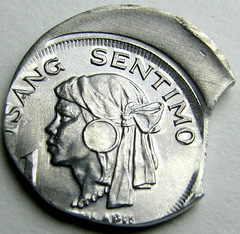

Errorscope editor, Jeff Ylitalo, showcases an array of Philippine Reform errors struck at U.S. Mint facilities. Featured are three Off Center strikes, including one with a large Curved Clip. His fourth coin is a Double Strike. He also includes images of pages from Domestic and Foreign Coins Manufactured by Mints of the United States 1793-1980, detailing a report from the Director of the Mint on Philippines’ coin production from 1967 through 1977.
[CAMIRE][B2]](https://farm8.staticflickr.com/7604/16583100974_f7777c53dc_m.jpg)
[CAMIRE][B2]](https://farm8.staticflickr.com/7692/17017802388_e3dd1f46c1_m.jpg)
Robert H. Knauss continues his series on Standing Liberty quarter errors and varieties by showing three different Multiple Errors, including the most spectacular entry, a 191X (full date not known) SLQ struck about 25% Off Center on an “origin unknown” nickel alloy planchet.
Ken Potter reports on 1964-P&D, 1953-S and 1955-S Roosevelt dimes boasting Doubled Die Obverses with the most prominent area of doubling being Roosevelt’s lips. Potter nicknamed them “Hot Lips” – a reference he borrowed from the famous 1888-O “Hot Lips” Morgan dollar doubled die.
Jon Sullivan reports on the Portland, OR, American Numismatic Association National Money Show detailing errors he saw and friends he met. He illustrates his article with a large number of error coins that were present plus images of many error-hobby personalities such as Fred Weinberg, Mike Ellis, Ken Hill and himself with his wife Ashton. Tom DeLorey writes about the discovery of a 1919 Winged Cap (Mercury) dime with a dramatic Doubled Die Obverse. In a news-flash, the editor also added in an image of the coin in an ANACS holder certified as VF-20.
Jason Cuvelier writes about locating specific errors and varieties. It documents his search for a 1965 Lincoln cent with dramatic clashed die marks on both the obverse and reverse and a 1945 Lincoln cent exhibiting a moderately strong doubled die obverse showing best on the date and Liberty, and a tad on Lincoln’s ear.
CONECA’s 20th/21st Century attributer of United States Die Varieties, James Wiles, shares a look at a few of the Doubled Dies and Repunched Mintmark varieties he’s listed in our files. Doubled Dies featured were all Lincoln cents including a 2009 “Log Cabin” Doubled Die Reverse, a 2013 Doubled Die Reverse and a 2014 Doubled Die Obverse. RPMs included two Lincoln cents dated 1938-D and 1945-S, a 1936-D Buffalo nickel and a 1912-S Barber dime.
Al Raddi explains how to describe an Off Center struck coin with an Off Center Position Gauge, (handily sized for reader use) and describes a good way to estimate how far off center a coin is.
The Member Finds column features a 1977 Mexican 100 Peso coin with a strong Doubled Die Obverse showing best on PLATA PURA 20 Gr. LEY 720 from Jeff Ylitalo and a 2000 Wide AM cent along with a No Date capped die strike from Pete Acampora.
Potter visits Die Deterioration Doubling (DDD) explaining how hard it is for newer collectors to differentiate this form of doubling from true Doubled Dies and Repunching. He suggests that a look at many examples is often the best way to help understand the effect since it often varies from coin to coin depending on the design, era in which it is struck, planchet material and even the finish used on dies. One of the eight images that he shows depicts a 1943-S zinc-plated steel cent with strong DDD that Potter indicates is common that strong due to the wear and tear the dies had to withstand to strike steel planchets. Potter also explains that DDD is often very strong on Canadian and other countries’ coins that chromium-plate their dies for extended use. He illustrates this point with examples of DDD on a1962 Canadian cent and five-cent piece.
Persons wanting to join CONECA should contact Rachel Irish at 3807 Belmont Rd., Coeur d' Alene, ID 83815 or by email at MRirish5@roadrunner.com. A copy of the application form may be download at http://conecaonline.org/content/join.html. Annual dues are as follows: Adult Member $25.00 per year, Young Numismatist (online Errorscope only) $7.50 per year or (online Errorscope plus mailed hard copy) $17.50. For Club and Family Memberships – ask Rachel or see the link above.
CONECA members wishing to receive a login username and password to access Errorscope Online, Members Only area, please email the Membership Coordinator, Rachel Irish at the address listed above. A valid email address on file with CONECA is required for access to current and back issues of ErrorScope online.
CATALOG REVIEW: D. BRENT POGUE COLLECTION, PART I
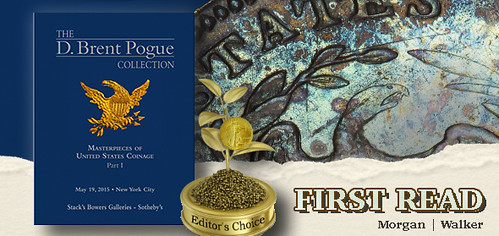
Auction catalogs occupy interesting and sacred spaces in Numismatics.
A catalog’s immediate goal is to entice potential buyers to place bids. To that end, catalogs are, in essence, long-form advertisements–a craft in and of itself.
Yet if we grant them further consideration, we find that catalogs become much more than that. Each one is a final accounting of the personal enterprise of collecting. They become part of the permanent ledger of taste, skill and success. And more than all of this, catalogs form the connective tissue between the hobby as we experience it today–in the flesh, in real time–and the hobby of yesterday.
Today’s catalogs are far different than the photo-starved and description-deficient booklets and broadsheets of the days of yore. To compare the two is to do reference work in the field of apples and oranges.
But for the serious scholars among us, a four-page listing of numismatic items published at the turn of the 20th century could be the sole reference point of the collector origin of a great American rarity, like those that pour out of the pages of Stack’s Bowers Galleries and Sotheby’s The D. Brent Pogue Collection: Masterpieces of United States Coinage, Part I.
The catalog’s primary writing credit goes to coin dealer John Kraljevich. Kraljevich, based in South Carolina, is a brilliant numismatist and highly knowledgeable in the field of Americana. He’s also a talented writer and columnist for Coin World Magazine. Q. David Bowers provided the assist, writing many of the catalog’s historical vignettes. Coin photography was handled by PCGS (though not specifically cited, one assumes Phil Arnold handled the imaging duties).
As a leisure read, we found Kraljevich’s approach to each listing to be workmanlike and understated. Lots follow a logical progression and the narrative of these early American coins unfolds freely, aided by an easy flow of technical and historical information. Lot listings yield vital information about the coin’s pedigree, rarity, and physical characteristics.
Yes, potential buyers are urged to bid, but it’s not a hard sell. Some catalogers try so strenuously to evoke excitement that isn’t there that one is reminded of the waitstaff at a chain restaurant promoting the daily special.
That the Pogue family assembled a majestic and historic collection goes without saying. The surprise announcement that the collection was coming to market caught many off guard, however, and the skittishness of the industry in its present state shows that the pending Pogue sales have hung like the sword of Damocles over the high-end coin market, despite the fact that Heritage Auctions has successfully maximized the profitability of the Eric P. Newman Collection over the course of several sales held in the past couple of years.
But the Newman and Pogue Collections are entirely different animals.
Newman, a first-class numismatist, owned a fair share of great rarities, but he was also an accumulator who owned hundreds if not thousands of “collector coins”. The result was that virtually any collector that wanted a Newman coin could get one.
The Pogues, on the other hand, were not accumulators.
The composition of their collection shows a dogged pursuit of the best-of-the-best and the rarest-of-the-rare.
To read the complete article, see:
First
Read: The D. Brent Pogue Collection: Masterpieces of United States Coinage, Part I
(www.coinweek.com/auctions-news/first-read-the-d-brent-pogue-collection-masterpieces-of-united-states-coinage-part-i/)

COURT ISSUES RULING ON CONFISCATED 1933 DOUBLE EAGLES
 The U.S. government must return 10 exceptionally rare gold coins worth millions of dollars each to a Pennsylvania family from which the
purloined coins were seized a decade ago, a federal appeals court ruled on Friday.
The U.S. government must return 10 exceptionally rare gold coins worth millions of dollars each to a Pennsylvania family from which the
purloined coins were seized a decade ago, a federal appeals court ruled on Friday.
By a 2-1 vote, the 3rd U.S. Circuit Court of Appeals in Philadelphia said Joan Langbord and her sons Roy and David are the rightful owners of the double eagle $20 gold pieces, after the government ignored their claim to the coins and missed a deadline to seek their forfeiture.
"The government knew that it was obligated to bring a judicial civil forfeiture proceeding or to return the property, but refused," Circuit Judge Marjorie Rendell wrote. "Having failed to do so, it must return the Double Eagles to the Langbords."
Patricia Hartman, a spokeswoman for U.S. Attorney Zane Memeger in Philadelphia, said: "We are weighing our options."
The Philadelphia Mint in 1933 produced 445,500 double eagles. But they were not circulated because President Franklin Roosevelt, trying to halt a bank panic, removed gold coins from circulation and made ownership of large amounts illegal.
Most of the coins were melted down, but a few were smuggled out, including one that fetched $7.6 million at a 2002 auction after having once been possessed by Egypt's King Farouk.
The government had long suspected without proving that the late Israel Switt, a gold dealer and father of Joan Langbord, had smuggled some of the coins with the help of a Mint employee.
It seized the Langbords' double eagles after the family located the coins in a safe deposit box once belonging to Switt, and sought to have the Mint authenticate them.
To read the earlier E-Sylum article, see:
JUDGE ISSUES RULING ON CONFISCATED 1933 DOUBLE EAGLES
(www.coinbooks.org/esylum_v12n31a12.html)
To read the complete article, see:
U.S. must return rare double eagle gold
coins to family (http://news.yahoo.com/u-must-return-rare-double-eagle-gold-coins-185510525--finance.html)
NOTES FROM E-SYLUM READERS: APRIL 19, 2015
Beautiful Coins
 Hubert
Walker writes:
Hubert
Walker writes:
This animated short called "Beautiful Coins" (2015), features the national coinage of Europe as they looked right before the euro replaced each one.
To view the video, see:
Beautiful Coins (https://vimeo.com/124400218)
More Magic With Die Photos
David T. Alexander writes:
The reference to photos of medal dies recalled my photo-adventure with my article for "The American Numismatic Association Centennial Anthology" back in 1991. My story "The Circle of Friends of the Medallion, an Appreciation in American Medallic History" occupied pages 143-166. A highlight in preparing the story was my acquisition of an original obverse die for Victor D. Brenner's 1911 Motherhood Medal, a huge and heavy block of die steel that I sent in for photography.
The plan was to position the cylinder on a flat surface and shoot from an angle to show the die shank, the "shoulder" and die face. There was some confusion as the first editor, the late Carl W.A. Carlson was in failing health and was replaced well into the work by Michael J. Hodder. When the book was received, I discovered that someone at ANA headquarters had taken the black and white die photo, flipped it, cropped the die face on the theory that this was a medal illustration! Needless to say the whole effect of the die were lost and the oddly ovoid illustration looked like nothing more than a squashed medal! Magic moment.
To read the earlier E-Sylum article, see:
IDENTIFYING MEDALS FROM A PHOTO OF THE DIE
(www.coinbooks.org/esylum_v18n15a19.html)
On the American Geographical Society Library
Regarding the American Geographical Society library, Leon Saryan writes:
I was a postdoc at UW-Milwaukee from 1975-1981 and well remember the transfer of the AGS library to our campus. I also spent time studying the collection. The acquisition of the map collection in its entirety by the library was considered a major coup at the time, and indeed it raised the prestige of the University. Great article.
To read the earlier E-Sylum article, see:
THE AMERICAN GEOGRAPHICAL SOCIETY LIBRARY
(www.coinbooks.org/esylum_v18n15a30.html)
Query: Buff & Berger Medal Sought
Anne Bentley of the Massachusetts Historical Society writes:
My letter to editor John W. Adams in our MCA Advisory (Vol. 17, no. 6 Nov/Dec 2014) has brought no responses, so I’m casting a wider net. I’m looking to see if anyone has an example of a Buff & Berger medal in their collection. An enquiry to our society led me to research the firm. I won’t repeat my letter, but will say they were in business only from 1871-1898, so there can’t be too many floating around out there.

SMITHSONIAN DIGITIZING 250,000 BEP PROOFS
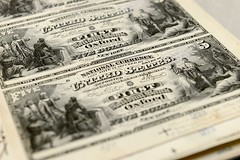 There is a very exciting new project at the Smithsonian! They are now scanning the federal proof
sheets via a flatbed scanner and conveyor system. It scans the sheets using a “rapid capture” system that refers to the speed of the
workflow. Before this process was in place, digitizing a single sheet could take as much as 15 minutes, at a cost of $10 per sheet. Now,
the team works through 3,500 sheets a day, at less than $1 per sheet. The Institution has asked the public to help transcribe through its
Smithsonian Transcription Center, so if you are interested, contact them. They scanned all of the Museum of Natural History’s bumblebees
this summer, so flat sheets should be a breeze.
There is a very exciting new project at the Smithsonian! They are now scanning the federal proof
sheets via a flatbed scanner and conveyor system. It scans the sheets using a “rapid capture” system that refers to the speed of the
workflow. Before this process was in place, digitizing a single sheet could take as much as 15 minutes, at a cost of $10 per sheet. Now,
the team works through 3,500 sheets a day, at less than $1 per sheet. The Institution has asked the public to help transcribe through its
Smithsonian Transcription Center, so if you are interested, contact them. They scanned all of the Museum of Natural History’s bumblebees
this summer, so flat sheets should be a breeze.
In the age of credit cards, Bitcoin and mobile payments, it's hard to believe that the proofs once used to create paper money can be as significant as priceless works of art. In the 19th and early 20th centuries, American states issued their own bank notes, made from metal plates engraved by hand. For immigrants at the time, the money in their pockets meant more than just opportunity; the scenes printed on them, such as Benjamin Franklin flying his famous kite, taught them about American history.
As the Smithsonian works to digitize its collection of 137 million items, the Digitization Program Office has turned to the National Numismatic Collection housed at the Smithsonian's National Museum of American History along with other legal tender such as bank notes, tax stamps and war bonds. The 250,000 pieces of paper will become the Institution’s first full-production “rapid capture” digitization project.
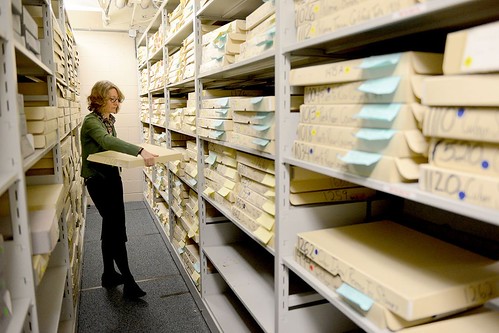
The project team, made up of 20 people hailing from a handful of departments across the Institution, began its pilot effort last February and moved forward in October, around Columbus Day. That’s fitting, because some of the proofs depict Columbus discovering America. “This is a lost art form,” says Jennifer Locke Jones, chair and curator of the Division of Armed Forces History. (Even Jones admits she no longer carries cash.)
The process uses a conveyor belt and a custom-designed 80 megapixel imaging system, making details available to the world that had only ever been seen by a select few. (By contrast, the new iPhone camera has only eight megapixels.) The conveyor belt resembles the ones used by security at airports. Markings on the belt guide team members in placing the sheets. The belt advances when the sheet at the end has been removed. Such equipment has never before been used in the United States.
Before such state of the art technology, digitizing that daily amount would have taken years, says Ken Rahaim, the Smithsonian's digitization program officer. “Prior to this,” Rahaim says, “nobody ever thought in terms of seconds per objects.”
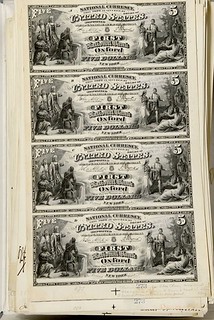 Rahaim says the project is on schedule to conclude in March. Transcribing the information from the
sheets into the online system must be done sheet by sheet, and will continue after digitizing has wrapped. The Institution has asked the
public to help transcribe through its Smithsonian Transcription Center. For this project, transcribers have completed 6,561 pages, each
with information about what bank and city the sheet is from, what date the original plate was made, and other numismatic details.
Rahaim says the project is on schedule to conclude in March. Transcribing the information from the
sheets into the online system must be done sheet by sheet, and will continue after digitizing has wrapped. The Institution has asked the
public to help transcribe through its Smithsonian Transcription Center. For this project, transcribers have completed 6,561 pages, each
with information about what bank and city the sheet is from, what date the original plate was made, and other numismatic details.
The quarter-million sheets, each unique, were used to print money from 1863 to 1930. They entered the Smithsonian’s collections from the Bureau of Engraving and Printing between the 1960s and 1980s, and because the original engraved plates no longer exist, these sheets are the only surviving record and essential to the country’s monetary history. “People have never seen this collection. Most numismatists have no idea what’s here,” Jones says. Some of the designs even came from works of art, including paintings now hanging in the nation’s Capitol.
Aside from the occasional sheets stuck together, which causes a few seconds of delay, things have moved smoothly. “There’s a large element of human checking that still needs to happen at every point in the process,” Jones says.
“We have unlocked the ability to do this efficiently and at a price that was unheard of before,” Rahaim adds. “Digitizing a whole collection, it was an abstract concept, but these processes are now making that a reality.”
To read the complete article, see:
Museums Are
Now Able to Digitize Thousands of Artifacts in Just Hours
(www.smithsonianmag.com/smithsonian-institution/museums-are-now-able-digitize-thousands-artifacts-just-hours-180953867/)
THE EARLIEST U.S MINT PURCHASE OF ALUMINUM?
John Dannreuther writes:
There was a question at some point about the Mint's purchase of Aluminum. I found a record from the latter part of the 1860s that you published in The E-Sylum.
While reviewing some written Mint records (I have copies, but Fred Weinberg has the originals), I found an earlier purchase of Aluminum.
On October 24, 1861 Victor Bishop of New York was paid $9.45 for 3 ounces. Expensive!
I missed this the first time I looked for purchases of this "precious" metal. This might be the first purchase of Aluminum, as the first patterns in this metal are from 1863.

To read the earlier E-Sylum article, see:
WHEN ALUMINUM COINS WERE STRUCK (www.coinbooks.org/esylum_v18n01a12.html)
THE HIGLEY KING AND THE PERILS OF OVER-SPECIALIZATION
 In the last issue, I talked about some of my mistakes as a rookie collector. This time around I will reveal one ridiculous idea I came up
with as a newbie coin dealer. I admit to feeling a bit sheepish about revealing this, but here goes-
In the last issue, I talked about some of my mistakes as a rookie collector. This time around I will reveal one ridiculous idea I came up
with as a newbie coin dealer. I admit to feeling a bit sheepish about revealing this, but here goes-
I've always had a fascination with the Higley copper. Maybe it is the fact that it was made here in Connecticut where I live, from copper mined locally. Maybe it is the oddly simple designs. Maybe it is the story behind them. Maybe it is because they are so rare. But no matter – I just like 'em.
I have been fortunate over my career to have bought and sold several Higley coppers. But when I first started setting up at shows, I came up with the brilliant idea to specialize in Higleys. Pure genius, right?
Well, for folks who don't know much about Higley coppers, there are maybe 70 or 80 of them in existence, spread over several varieties (including the unique one mentioned above). The appearance of just one Higley in any condition would be a highlight of most coin auctions.
Back when I started buying and selling at local shows, I must have thought there were people who were going to these local coin shows that had Higley coppers with them. After all – why wouldn't they? They were made locally. Sure, that was back in the 1730's, but perhaps they were family heirlooms.
And perhaps they were to bashful to offer them to dealers for sale. Unless, of course, they were prompted to do so. Prompted, lets say, by a sign at a certain dealer's table:
I came across that sign again in a storage room about a month ago. Yes – that a real sign, and not one I just made up today as a joke. I actually displayed it at local coin shows for a few months when I started out in the early 1980's.
Even more ridiculous were my thoughts at the time. I remember thinking – “Yikes – what if I was offered more than one at a show? I mean – these things are worth $3000 to $5000 each (that was the going rate at the time. They are $30,000 to $80,000 now, and more for nice ones). Can I afford to buy two or three at once? And how long would I have them in stock?”
Well, as you might have guessed, I needn't have worried. No one offered me even one. No one even commented on my sign. I guess this wasn't the path to my becoming the Higley King.
To read Dave's newsletters online, see:
Making the Grade (www.davewcoins.com/newsletter)
THE BOOK BAZARRE
HELP SOUGHT FOR CENSUS OF CASTORLAND JETONS
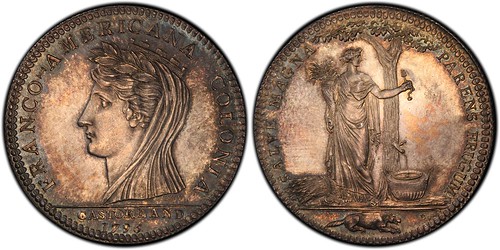
Image from CoinFacts.com
A Descriptive Census of Castorland Jetons
The census aims to establish a data base of original-die Castorland jetons which are French (non-royal) jetons, a private commercial issue commissioned by The New York Company (La Compagnie de New York). Designed and engraved by Benjamin Duvivier, former Engraver General of the French mint, the jetons are all dated 1796. Their issuance was authorized by Title Five, Article nine of the company’s charter (Constitution) which became effective on the 28th of June 1793. They were struck on a fee basis at the Paris mint (La Monnaie).
The New York Company owned a large tract of development land in upstate New York which the jetons refer to by name in exergue on the obverse, CASTORLAND. The obverse legend reads FRANCO-AMERICANA COLONIA, a further reference to the company’s New York land venture, and the coin’s reverse iconography endorses the land venture with positive images: a cornucopia symbolizing fruitfulness, a beaver (castor in French) symbolizing the fur trade, and a maple tree promising maple sugar.
Information can be taken from various sources. The most reliable source is a raw coin in hand, available for study with magnification. The next best source is a “holdered” coin in hand. Even with the new edge-view holders a determination of flan thickness and edge milling and edge marks is unreliable. The next best source of information is a digitalized photograph like those in the Heritage Auctions archive. And the least reliable source is information taken from sale catalogues. Caution should be exercised when considering the written descriptions of coins offered for sale. Both the seller and the seller’s agent have an interest in presenting the coin in its most positive light. Historical statements about Castorland jetons vary widely, and many are outright fanciful.
The four basic identifiers are: metal, flan thickness, die alignment, and edge milling. In addition to those identifiers the census uses four incidental identifiers. The first of which is die etching, the second is flan drift, the third is metal flow, and the fourth is evidence of the reverse die break at the S of PARENS, noted as S bulge and S break.
THE MYTH OF APPOMATTOX
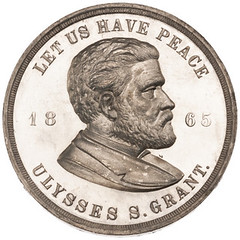

The 150th anniversary of the surrender of General Robert E. Lee’s Confederate army at Appomattox was commemorated in New York City this weekend with some celebratory cannon shots from Castle Clinton in Battery Park. Historian Gregory P. Downs also had an excellent column in the New York Times about some of the pernicious myths that cloud our understanding of this hallowed event. As Downs points out, the war hardly ended at Appomattox, as Southerners continued to violently and rather successfully resist efforts towards racial equality in the years that followed.
This ongoing struggle and the violence, though, has largely been obscured by the myth of reconciliation at Appomattox, where Confederate soldiers were supposed to have accepted their defeat graciously, stacked their arms, and returned to peaceful civilian lives. One of the remarkable things about what Downs calls the “myth of Appomattox” is how quickly it took hold. See, for example, this medal issued by Quint and Sons of Philadelphia for Grant’s 1868 presidential campaign.
The medal burnished Grant’s image as a magnanimous victor, and someone focused on peace and reconciliation rather than continued conflict. Grant was clearly aware of the problems posed by recalcitrant Southerners and made some aggressive but ultimately ineffectual moves to see Reconstruction through. These efforts were in part undermined by the growing legend of Appomattox and peaceful rapprochement. Indeed, this was something that the reverse of the medal articulated explicitly with the redolent symbolism of stacked arms.
The plowing horse image and quote referred to Grant’s decision to allow Confederate troops who owned their own horses to take them with them after the surrender. The idea, related by Grant in his memoirs, was that this would make it easier for the soldiers-cum-farmers to “put in a crop to carry themselves and their families through the next winter.” This conciliatory gesture became part of the myth of Appomattox.
To read the complete article, see:
THE MYTH OF APPOMATTOX
(www.anspocketchange.org/the-myth-of-appomattox/)
VICTOR DAVID BRENNER’S LINCOLN PLASTER
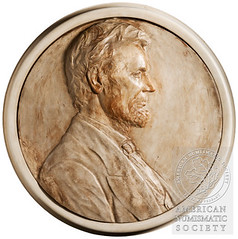

During his time in office, Teddy Roosevelt undertook a more or less comprehensive redesign American coinage. As the centenary of Lincoln’s birth approached in 1909, a large number of medals and tokens were being manufactured as souvenirs, and Roosevelt began to consider a way to honor one of his Republican heroes. This would be a departure from precedent as the first federally-issued coin to feature an actual person (as opposed to an abstract representation of ‘Liberty,’ or an ‘Indian Head,’ etc.). It seems that it was only by chance that the talented Litvak-American sculptor Victor David Brenner (1871-1924) was chosen for the job.
Brenner was commissioned to make a medal to be awarded for service on the ongoing Panama Canal project. In this context the President sat for the artist in late 1908, and it was at this time that he likely encountered a plaque that Brenner had sculpted of Lincoln for the Gorham Manufacturing Company. Roosevelt clearly admired his work, and although the precise details remain unclear, Brenner was engaged to produce a new design featuring Lincoln for the cent. It was a project he worked on through the winter of 1908-1909 and into the spring.
In 1989, the American Numismatic Society received a large plaster portrait of Abraham Lincoln by Victor David Brenner. It was donated by David R. Lit, the nephew of the sculptor’s wife, Ann Reed Brenner. It is undoubtedly one of the plaster models that Brenner made in late 1908 or early 1909 as he was working on the design for what would become the Lincoln cent.
The plaster portrait measures 610 mm or 24 inches in diameter. It was the typical process at the time to produce a large model so that the artist was able to get the desired detail before a machine called a Janvier reducing lathe was used to copy the design onto a coin-sized hub. A comparison of this plaster with the finished cent shows that it was probably not the model used for production, though it remains a possibility as Brenner voiced complaints about the loss of detail when the Mint reduced his large designs. After sorting through some final design and production issues, over 20 million pennies were minted that summer and the new cent was released to the public on August 2, 1909 to wide acclaim.
To read the complete article, see:
VICTOR DAVID BRENNER’S LINCOLN PLASTER
(www.anspocketchange.org/victor-david-brenners-lincoln-plaster/)
THE BOOK BAZARRE
SOME INTERESTING MEDALS: APRIL 19, 2015
DIANA ASHTRAY
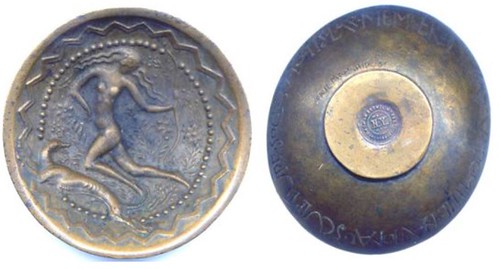
DIANA ASHTRAY FOR THE NATIONAL SCULPTURE SOCEITY, 1915. Murtha 67. 3.75”
Bronze. Very Fine. Cast by the Roman Bronze Works. This is the earliest of Manship’s works in this genre and was commissioned by the National Sculpture Society as a gift to its lay members. He chose the goddess Diana for his subject and this work is an obvious precursor to his later sculpture of the same subject.
The impression of motion achieved in the figures is astounding and the fluidity of the figure of Diana is ripe with early Minoan influences. The hound exudes physical power and lightning speed as he bounds at her side. The encircling beaded border barely contains the pair giving the impression they might leap from the bowl at any moment. The inscription circling the outside rim (FROM THE NATIONAL SCULPTURE SOCEITY TO ITS LAY MEMBERS MCMXV.) is given as much attention as the figures within. Signed both in the bowl and around the base, it is one of only two works to be signed twice by the artist. $695.00
CARNEGIE CORPORATION ASHTRAY

CARNEGIE CORPORATION ASHTRAY, 1927. Murtha 231. 5.4”. Cast Bronze.
Paul Manship, Sc, Extremely Fine. The border is inscribed: CARNEGIE CORPORATION FOR THE ADVANCEMENT AND DIFFUSION OF KNOWLEDGE AND UNDERSTANDING. Banner engraved, PRESENTED TO/ FRANK AYDELOTTE. Franklin Ridgeway Aydelotte was President of Swarthmore College (191-1940) and was also the director of the Institute for Advanced Study from 1939 until 1947.
"Societal acceptance of smoking resulted in this work, the second ashtray to be commissioned by a major organization. It was awarded for outstanding effort in an educational context within the organization and utilizes the rearing form of Pegasus as its central theme. In Manship’s oeuvre, the winged steed is symbolic of artistic inspiration or as a means of transport to higher realms, in this case knowledge. Stylized waves crash against the crystalline rocks to symbolize the diffusion of knowledge, wearing them away and carrying the grains around the globe. These crystals also, like knowledge, are ever growing and serve as a bulwark against the tempest of chaos." $995.00
CONQUEST OF SPACE MEDAL
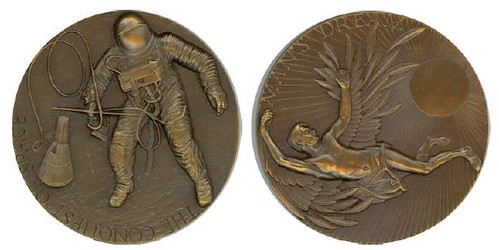
CONQUEST OF SPACE MEDAL, 1971. 63.5mm. Bronze. Paul Calle, des. & Joseph DiLorenzo, Sc. (MACO) Edge numbered. "0237" Choice Unc. Obv: Astronaut in space hooked to line from capsule. THE CONQUEST OF SPACE. Rx: MAN'S DREAM above flying figure of Icarus and radiant sun.
Originally issued as part of a matched serial numbered set of silver and bronze medals limited to 250 sets. An unknown number of additional serially numbered medals were struck without being included in matched set boxes. However, judging from the paucity of auction appearances, there probably were not many. $85.00
HENNING COUNTERFEIT NICKELS SOUGHT IN RIVER
 Francis LeRoy Henning of Erial may not be a household name to most folks in New Jersey, but to treasure hunters and coin collectors,
Henning's name is notorious for counterfeiting what coin enthusiasts call "The 1944 Henning Nickel."
Francis LeRoy Henning of Erial may not be a household name to most folks in New Jersey, but to treasure hunters and coin collectors,
Henning's name is notorious for counterfeiting what coin enthusiasts call "The 1944 Henning Nickel."
In the early 1950s, Henning, a counterfeiter by trade, set out to fake Jefferson nickels from the World War II era (1942-45). Nickel alloy at that time was more important for the government to make armor plates for the war effort, so the official 5 cent piece was minted with a combination of copper, silver and manganese. An identifying mark of either "P" (Philly), "S" (San Francisco) or "D" (Denver) was printed on the tail side of the coin.
Henning claimed to cut the dies for his coins directly from real coins using a machine he invented, but this has been disputed by coin collectors. Henning forgot one important impression: the mint mark of the state of origin on the back of his coins. The coin also had another minting flaw; there was a small indentation in the "R" in the word "Pluribus." His coins were minted with monel metal, a mixture of copper, nickel and iron. (Monel metal is mostly copper, around 80 percent).
It has been estimated that Henning produced almost a half-million of these nickels in 1954, and nearly 100,000 of them went into circulation before the Camden County Coin Collectors Club noticed the missing mint mark and tipped of the Secret Service early in 1955, who traced the operation back to Henning's home in Erial.
Weird NJ met with treasure hunter Neil Schwartz at a secret location along the Cooper River in Cherry Hill. Neil has been doing research for the last few years as to where Francis LeRoy Henning dumped an estimated 200,000 or more counterfeit nickels in the river before he was caught by the feds in 1955.
Neil, who is the webmaster for WestJerseyDetecting.com is a "Dirt Fisher," a term used for treasure hunters and coin collectors. The site started out as an extension of his hobby and he would post photos of his treasure and coin finds for like-minded enthusiasts. Neil showed us the approximate location where he believes Henning dumped his coinage, and plans on recovering those that he can find.
I heard about Henning and the nickels in 2005 through various forums, and found out Henning lived just around the corner from here in Erial. He was a machine shop operator. I've viewed photos of the river that were taken in 1950, and with floods and erosion over the years, the river has changed a bit. I managed to track down two eyewitnesses who were kids at the time who showed me where the Secret Service was digging and dredging the river. They didn't know each other, but they basically both told me the same location. They said at the time the Secret Service was pulling up bucketfuls of nickels.
The schoolchildren from the local school were coming down and grabbing them. It got to the point where the Secret Service had to go to the school and tell the children about how counterfeiting is illegal and they would have to turn in whatever they found. The spot is close to a road, which makes sense because Henning was trying to dump a heavy load in a hurry.
To read the complete article, see:
Weird NJ: Treasure Hunting
for Plug Nickels (www.app.com/story/news/local/new-jersey/weird-nj/2015/04/19/weird-nj-henning-nickels/26026741/)
CNG AUCTION 99 CLOSES MAY 13, 2015
Classical Numismatic Group of Lancaster, Pennsylvania and London, England is proud to present Auction 99, an Internet and Mail Bid Sale closing electronically on Wednesday, May 13, 2015, from 10 AM ET (U.S.). CNG 99 features 1318 lots of ancient Greek, Celtic, Oriental Greek, Central Asian, Roman Provincial, Roman Republican, and Roman Imperial coinage. Additionally, there are featured selections of Byzantine, Early Medieval, Islamic, World Coinage & Medals, and British Coinage & Medals. The pre-sale estimate total for CNG 99 is $1,805,000.
The Greek section of the sale features coins from the collection of Alexandre Carathéodory Pasha (1833-1906), a very rare Starr Group IV silver didrachm of Athens, a prototype gold stater of Kroisos, an offering of previously unknown silver staters of Phaselis, and an extremely rare ‘Horned Horse’ type silver tetradrachm of Antiochos I from the Aï Khanoum mint.
Other highlights include a selection of rare Arabian coins, a very rare Antioch silver tetradrachm of Tiberius and Divus Augustus, an important offering of tetradrachms of Aelia Capitolina, and an exceptional Social War silver denarius from the Marsic Confederation. The Roman section of the sale features a diverse selection of Roman Imperial gold coinage, which includes the third known Severus II gold aureus from the Alexandria mint.
Byzantine coins from the collection of Prue Morgan Fitts, author of The Beginner’s Guide to Identifying Byzantine Coins, are featured in CNG 99, as well as Axumite coins from the Joan Wilde collection. Joan Wilde died last November, and was the wife of the late Adna G. Wilde, who served as the American Numismatic Association’s Executive Director (1968-72), President (1981-83), Treasurer (1983-2008), and Parliamentarian (1994-2008). Joan usually accompanied her husband to ANA conventions and other coin shows, and she became interested in the coinage of Ethiopia’s ancient Axumite Empire.
World coinage in CNG 99 is highlighted by French Feudal issues from the Michael Joffre collection. One of four known Anglo-Saxon gold thrymsas of the ‘Clasped Hands’ type is featured in the British coinage section, and an important 1836 Gobrecht Proof silver dollar from the Dr. Julius Korein collection is offered for the U.S. coin specialist. The Korein Gobrecht dollar is sold on behalf of the American Numismatic Society to benefit their North American Chair.
Another highlight of CNG 99 is a Northern California collection of world coins and medals. This collection features a diverse selection of Latin American coinage and proclamation medals, Caribbean cut countermarked issues, German Sede Vacante medals, and Philippine countermarked issues. The Latin American coinage is especially strong in Mexican coinage from colonial to United States issues.
Some of the individual highlights from CNG 99 are:
Greek Coinage

Lot 121–ATTICA, Athens. Circa 475-465 BC. AR Didrachm (19mm, 8.49 g, 11h). Head of Athena right, wearing earring, necklace, and crested Attic helmet decorated with three olive leaves over visor and a spiral palmette on the bowl / Owl standing right, head facing; olive sprig to left, AΘE to right; all but one leaf of olive sprig within incuse square, the totality within incuse circle. Starr Group IV, 142 var. (O122/R– [unlisted rev. die]) = Svoronos, Monnaies, pl. 9, 14 = Seltman 471 = SNG Berry 642 (same obv. die); HGC 4, 1617 corr. (Starr groups; same obv. die as illustration); SNG Copenhagen 30; Boston MFA 1602; Hunterian 10; Rhousopoulos 1979. Good VF, toned, slight granularity. Well centered on a broad flan. Very rare, fewer than 50 didrachms of this type (Starr Groups II–IV) known, of which only about a dozen remain in private hands. Estimated at $15,000

Lot 198–TROAS, Ophrynion. 4th century BC. AR Tetrobol (15mm, 2.64 g, 12h). Bearded head of Hektor facing, wearing triple crested Attic helmet / Nude youth, holding palm in right hand, rein in left, on horseback right; OΦPYNEΩN above. SNG Ashmolean –; SNG von Aulock 7630; SNG Copenhagen –; SNG München –; BMC –; Traite II 2420 = MG 176. Good VF, darkly toned. Extremely rare, perhaps the third and probably the finest known. Estimated at $3,000
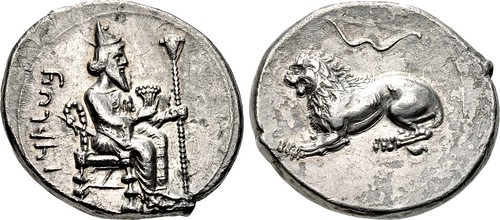
Lot 315–CILICIA, Tarsos. Mazaios. Satrap of Cilicia, 361/0-334 BC. AR Stater (22.5mm, 10.57 g, 5h). Crowned figure of Artaxerxes III in the guise of Baaltars seated right on throne with back terminating in swan’s head, holding lotus flower in right hand, lotus-tipped scepter in left; B’LTRZ (in Aramaic) to left, M (in Aramaic) to lower right / Lion recumbent left; bow above. Casabonne Series 6; Newell, Myriandros 1; SNG France 422 var. (legend retrograde; Myriandros); SNG Levante Supp. 26 (this coin; Myriandros); Jameson 1621 var. (legend retrograde). Near EF, toned, minor roughness on reverse. Very rare, and only the second specimen at auction since NFA XXV in 1990 (Triton XVIII, lot 88 [realized $30,0000] was the first). Estimated at $10,000
From the Edoardo Levante Collection. Ex Numismatic Fine Arts XXV (29 November 1990), lot 186.
The attribution of the walking-lion series of Mazaios had originally been given to the mint of Tarsos, but Newell argued that they more likely were struck at Myriandros in his study of that mint in AJN 53 (1919). Later, J.D. Bing, in AJN 1 (1989), argued for an alternative attribution of the Myriandros coinage to the mint of Issos. While most numismatic works continue to follow Newell, Casabonne’s significant study of Cilicia during the Persian period convincingly returns these coins of Mazaios to the mint of Tarsos (cf. Casabonne, pp. 215–7).
The appearance of Baaltars on this issue is significantly different from the relatively standard depiction of the deity on other coins of Tarsos. While the deity is typically shown nude to his waist, here the figure is fully clothed with attire that closely resembles that on the figure that appears on the royal Persian coinage struck at Sardes. More significant, though, is the headdress on the figure. Baaltars typically wears a laurel wreath or no headdress, while this portrait shows the figure wearing an elaborate headdress. In a recent article, Frank Kovacs analyzed the type, and argued that this figure is actually the Great King Artaxerxes III Ochos, in the guise of Baaltars, and the headdress is the combined crown of Upper and Lower Egypt, thus his appearance here is as pharaoh of Egypt (cf. F. Kovacs, "Two Persian Pharaonic Portraits" in JNG L [2000]; see also M. Thompson, in MN XII [1968], pp. 11–2, who notes the figure wearing a "high crown of Egyptian type"). This is plausible, as Artaxerxes was the first pharaoh of the Thirty-First Dynasty of Egypt, and the date of his rule there, 343-338 BC, comports well with this issue under Mazaios.
O. Casabonne, while acknowledging that the figure here may represent a synthesis of Baaltars and the Great King, disagrees with the identification of the headdress as the Egyptian crown. Instead, he views the headdress as being a Phrygian style cap that is often depicted in contemporary art as being worn by warriors (cf. Casabonne, p. 121, fig. 8), but is here shown with the cheek guards in a raised position.
Nonetheless, it is doubtless that the figure here is a synthesized portrait of Baaltars and the Persian Great King. The fractional silver of this issue (see Triton XVIII, lot 89), interestingly, may be most instructive, as the headdress on the figure is shown wearing a crown that is identical to that on the figure of the royal Achaemenid coinage and his robes have interlocking circles reminiscent of the darics of Carradice Type IV Late (cf. M. Thompson, op. cit., p. 12).
Roman Provincial Coinage

Lot 441–PONTUS, Neocaesarea. Severus Alexander. AD 222-235. Æ (30mm, 15.36 g, 12h). Dated CY 163 (AD 226/7). Laureate and cuirassed bust right / Two-storied portico (nymphaeum?) with central arch in which stands Tyche holding rudder and cornucopia; ЄT PΞΓ (date) in exergue. Çizmeli – (D3/R– [unlisted rev. die]); Price & Trell fig. 71 (for rev.). VF, attractive earthen green patina. Fine style portrait and exceptional reverse. Very rare. Estimated at $1500
Çizmeli cites only three specimens with this reverse type, all of which were paired with a cruder obverse die engraved with a more youthful bust.
Price and Trell (pp. 43-4) include this type with other coins depicting nymphaea, but caution that “...the building at Neocaesarea resembles a gate more than a fountain and certainly does not have the spouts at the base to indicate the nature of the monument.”
Roman Imperial Coinage
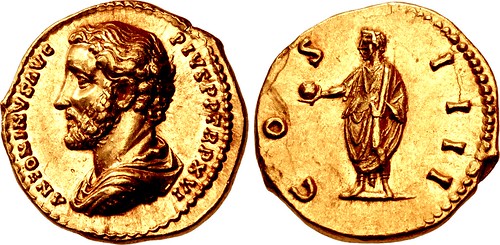
Lot 641–Antoninus Pius. AD 138-161. AV Aureus (19.5mm, 7.31 g, 6h). Rome mint. Struck AD 152-153. ΛNTONINVS ΛVG PIVS P P TR P XVI, bareheaded, draped, and cuirassed bust left / COS IIII, Antoninus Pius standing left, holding globe and volumen. RIC III 226e; Strack 257; Calicó 1523 = Biaggi 714 (same obv. die); BMCRE 798 (same obv. die). EF, underlying luster, a tiny contact mark on obverse, a pair of light scratches on reverse. Wonderful portrait. Estimated at $7500
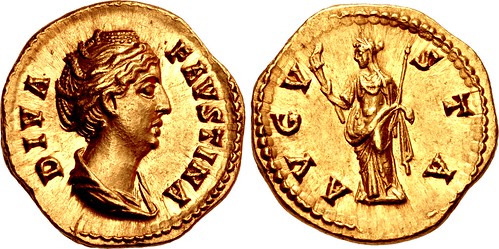
Lot 649–Diva Faustina Senior. Died AD 140/1. AV Aureus (20mm, 7.29 g, 6h). Rome mint. Struck under Antoninus Pius, circa AD 146-161. DIVA FAVSTINA, draped bust right, wearing hair bound in pearls / AVGV STA, Ceres, veiled, standing left, holding torch in right hand and scepter in right. RIC III 356a (Pius); Beckmann dies df21/CA21; Strack 469; Calicó 1763a; Biaggi 812; BMCRE 395 and 397 (Pius). Superb EF, lustrous. Estimated at $15,000
Printed catalogs for CNG 99 are now available. To order a catalog, please visit www.cngcoins.com. Catalogs are $50 to North American addresses, and $75 to the rest of the world. Payment may be made by U.S. $ check or Visa/MasterCard. Catalogues have been mailed to customers on CNG’s active mailing list. Prospective bidders may also view the virtual catalog at CNG 99 Virtual Catalog.
For further details and any additional information, please contact CNG, Inc. at:
Classical Numismatic Group, Inc.
P.O. Box 479
Lancaster, PA 17608-0479
Telephone: (717) 390-9194
Fax: (717) 390-9978
Email: cng@cngcoins.com
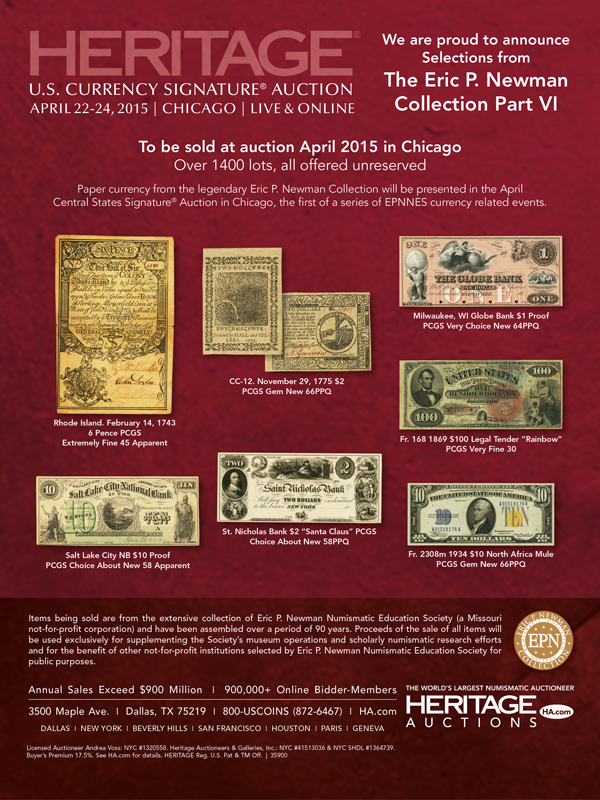
HERITAGE APRIL 2015 CICF AUCTION RECAP
As part of the Chicago International Coin Fair held last week at the Crowne Plaza in Rosemont, Illinois, Heritage Auctions held a signature auction of ancient and world coins. In this recap we will take a look at some of the highest prices realized at the main auction, which was held over several sessions. Some of the lots were discussed in our preview article, while others saw surprising results worth mentioning in this recap. Please note that all prices realized include a 17.5% buyers premium.

The first lot we will discuss is not a coin, but rather a different numismatic item of major importance, a very rare Brazilian gold ingot dated 1814 and produced in Sabara that was offered as lot 29419. Produced during one of the earlier gold rushes in South-America, these ingots had no denominations and never circulated as money. They are, however, very rare, as many were melted in later years, and only a few hundred different ingots of various producers and sizes are known to exist. The piece, graded “Essentially Mint State”, realized $82,500.
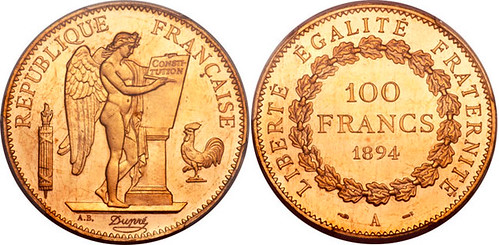
Selling for the same price was lot 29751, a very rare PCGS MS64 graded example of the 1894-A 100 Francs, which had an original mintage of just 143 coins. Part of a complete set of this iconic series that was offered in the auction, the date is obviously the key-date of the series, large gold coins struck at the Paris Mint around the turn of the century. It is also considered to be the finest known survivor of this date. With very few coins of this date coming to the market in recent years, the offering was a prime example of a rare coin that can bring out spirited bidding, with the coin realizing $82,250, about double the presale estimate of $35,000-$45,000.
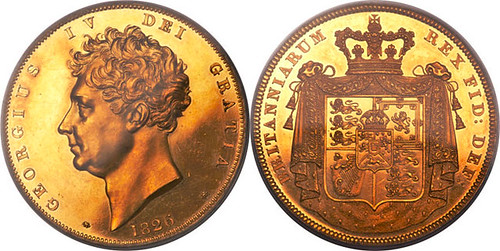
Another coin that performed much better than its presale estimate in the catalog was lot 29983, an 1826 PR62 Cameo 5 Pound Gold coin from Great-Britain, which realized $76,375. 5 Pound Gold coins are large heavy gold coins that were struck intermittently throughout the 19th century, but are generally rare, thanks to their large size and limited circulation. Proofs of many dates are of the utmost rarity, and this 1826 issue, featuring the bust of George IV on the obverse and the arms of Hanover on the reverse is no exception, as the price realized attests.
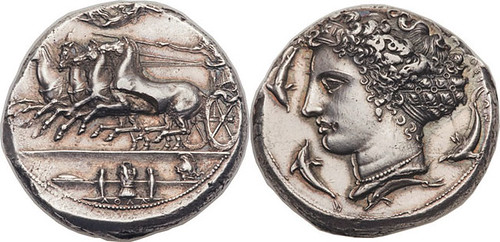
Many ancient coins performed very well, including the two lots that we discussed in our preview, a pair of silver decadrachm’s struck in Syracuse in Sicily during the time of Dionysius, which translates to approximately 406-367 BC. Offered as lots 29016 and 29017, the first brought $70,500 while the second one sold for $58,750. While the coins feature virtually identical designs, they were engraved by two different artists, as shown by their names that appear on the coins. These two coins are rare examples of ancient coins from which we know the name of the artist that created them, although nothing else is known about the two artists.
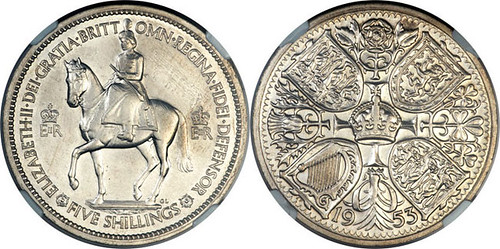
One more noteworthy result from the auction that we like to mention is lot 30063, which sold for $28,200 after the catalog placed an estimate of $8,000-$12,000 on the coin. The item in question is a very rare, possibly unique pattern for the Great-Britain 1953 Coronation Crown, a common issue struck in copper-nickel, which is easily found in uncirculated grades. The pattern issue, graded UNC Details (Inscription Removed) by NGC has the common obverse seen on the issued coin, but a different reverse. Queen Elizabeth II herself is said to have disapproved of the original design seen on this pattern, which shows certain emblems in a very large scale. The issued coin has these emblems placed on the reverse in much smaller format. This coin shows that the market for rare items from Queen Elizabeth’s lifetime are starting to attract more and more attention as she is said to overtake Queen Victoria as longest-reigning British Monarch later this year.
To read the complete article, see:
Heritage April 2015 CICF World & Ancient
Coins Signature Auction Recap (http://news.coinupdate.com/heritage-april-cicf-world-ancient-coins-auction-recap-4780/)
GIBRALTAR’S 1994 THREE GARRIDEBS CROWNS
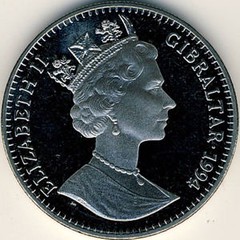

Gibraltar released 8 different designs for its 1994 series of coins commemorating the 100th anniversary of the return of Sherlock Holmes. In this post, we will discuss the three coins that have the theme of The Three Garridebs.
Edward C. Rochette, the 5th Garrideb, suggested the idea of a series of coins commemorating Sherlock Holmes while having discussions with Derek Pobjoy, the head of the Pobjoy Mint in the early 1990’s. Pobjoy Mint then struck 8 different designs in 3 metals – cupro-nickel, sterling silver and .999 fine gold.
OBVERSE: ELIZABETH II / (right facing bust of Queen Elizabeth II) / GIBRALTAR • 1994
REVERSE: • 100th ANNIVERSARY OF THE RETURN OF SHERLOCK HOLMES • / (Sherlock Holmes, seated left, holding magnifying glass in right hand and coin in left hand) conversing with a seated Dr. Watson on the right, in front of a bookshelf; coal scuttle to the left of the bookshelf) / THE / THREE / GARRIDEBS / 1 / CROWN
KM290 – Round, 36.60 mm, Cupro-Nickel, 28.28 grams, Reeded Edge, unknown mintage
KM290a – Round, 36.60 mm, .925 Sterling Silver, 28.28 grams, Reeded Edge, 30,000 minted
KM283 – Round, 22 mm, 1/5 ounce .999 Gold, 6.22 grams, Reeded Edge, 5,000 minted
The press release, issued by the Pobjoy Mint, announcing these coins is somewhat vague and implies that all three coins are Crowns. The Standard Catalog of World Coins 1900-1999 (whose KM catalog numbers we are referencing above) lists the gold coins as being a 1/5 Crown. If this is the case, a slight modification is needed to the reverse description above.
Issue prices were $6 for cupro-nickel, $35 for the sterling silver and $165 for the gold coins.
In a subsequent post, Greg adds:
You know what coins we don’t have pictures of? That’s right – the gold ones. Krause Publications doesn’t have them. Neither does the Pobjoy Mint.
Mintages of 5,000 struck for each design in gold has been confirmed with the Pobjoy Mint. Each coin carried 1/5 of an ounce of .999 fine gold, and were slightly smaller (22 millimeters) and weighed 6.22 grams.
So, does anybody out there have a picture of these 8 elusive gold coins? Better yet, do any of you own any of the 8 gold coins?
To read the complete articles, see:
Gibraltar’s 1994 Three Garridebs Crowns
(http://fourthgarrideb.com/2015/04/gibraltars-1994-three-garrideb-crowns/)
April HolmesWork
Assignment: Gibraltar’s 1994 Golden Sherlock Holmes Coins
(http://fourthgarrideb.com/2015/04/april-holmeswork-assignment-gibraltars-1994-golden-sherlock-holmes-coins/)

DOOLITTLE TOKYO RAIDERS CONGRESSIONAL GOLD MEDAL
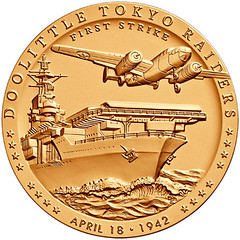
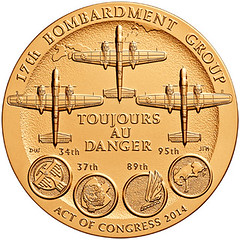
At a ceremony held on April 15, 2015 at Emancipation Hall in the U.S. Capitol Visitor Center, members of the Doolittle Tokyo Raiders were collectively awarded the Congressional Gold Medal.
Authorized under Public Law 113-106, the medal was awarded to the volunteers of the 17th Bombardment Group, led by Lt. Col. James Doolittle during World War II, who made the first strike against Japan on April 18, 1942. The top-secret mission called for the raiders to take off from an aircraft carrier approximately 450 miles outside of Japan, bomb select Japanese targets, and then fly to safety in unoccupied areas of China. The operation was risky, as medium bombers had never before flown from a carrier, and sailing so far into enemy territory was dangerous.
The medal’s obverse design features the North American B-25B Mitchell launching off the USS Hornet (CV-8), 16 stars representing the 16 flight crews that made up the Doolittle Tokyo Raiders, and the inscriptions “DOOLITTLE TOKYO RAIDERS,” “FIRST STRIKE,” and “APRIL 18, 1942.” The obverse was designed by Chris Costello and engraved by Don Everhart.
The reverse design features B-25B Mitchell aircraft approaching their target with four patches representing the four squadrons (34th, 37th, 89th, and 95th) that make up the 17th Bombardment Group. The inscriptions are “17TH BOMBARDMENT GROUP,” “TOUJOURS AU DANGER” (French for “Still in Danger”), and “ACT OF CONGRESS 2014.” The reverse was designed by Donna Weaver and engraved by Joseph Menna.
To read the complete article, see:
Doolittle Tokyo Raiders Congressional Gold
Medal (http://news.coinupdate.com/doolittle-tokyo-raiders-congressional-gold-medal-4785/)
More than seven decades after an audacious bombing run by the "Doolittle Tokyo Raiders" rallied their nation while stunning another, the World War II heroes are still adding to their legacy.
The group will receive the Congressional Gold Medal on April 15 in Washington, then present it to the National Museum of the U.S. Air Force on April 18 — the 73rd anniversary of the raid.
The gold medal will go on display at the museum near Dayton, joining an exhibit depicting the Raiders' launch from an aircraft carrier during their daring 1942 mission against Japan.
One of only three surviving Raiders, retired Lt. Col. Richard Cole, 99, plans to return to his native Ohio from Comfort, Texas, for the museum ceremonies. Another Raider, and family members who survive others who were on the mission, are expected to take part in the weekend of events, some of them private.
To read the complete article, see:
WWII
heroes to give congressional gold medal to Ohio museum
(www.zanesvilletimesrecorder.com/story/news/local/2015/03/29/wwii-heroes-give-congressional-gold-medal-ohio-museum/70644922/)
WAYNE'S NUMISMATIC DIARY: APRIL 19, 2015
Some numismatists are also accomplished poets. On Monday I got this email from Fred Michaelson:
A gift I ain't bought her.
But happy birthday to your daughter!!
She turned 11 this week, but Sunday was the big day of celebration. We don't have birthday parties in our family - for the kids, they're more like Birthday Festivals. This one included a nice lunch with the family at Benihana, and a kid dinner party at an indoor trampoline arena with pizza and cake.
Tuesday was the monthly meeting of my Northern Virginia Numismatic Social group, Nummis Nova. Eric Schena was our host, and he picked Clyde's Restaurant at Reston Town Center. It was a good choice - the food and drinks were great, the staff was attentive, and as usual the numismatic fellowship was a delight.
I took a seat at our long table between Aaron Packard and Roger Burdette, and across from Chris Neuzil. Other attendees included regulars Lenny Goldberg, Mike Packard, Wayne Herndon, Joe Levine, Gene Brandenburg, Dave Schenkman, Julian Leidman and Steve Bishop. We were delighted to have Howard Daniel back in town and also be joined by my guest, former U.S. Mint Director Ed Moy, who found a seat at the end of the table between Wayne and Eric. Here's a group photo:
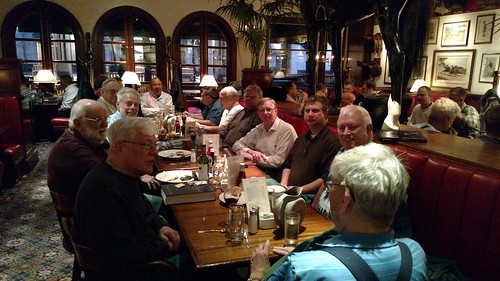
From left, going clockwise: Dave, Gene, Chris, Joe, Lenny,
Wayne Herndon, Ed, Eric, Mike, Roger, Wayne Homren, Aaron, Steve, Julian
Topics at my end of the table included Chris Neuzil's research on War of 1812 medals, my work on the Newman Numismatic Portal, and plenty of non-numismatic topics from horrible Reston restaurants to my days working at Bell Laboratories.
Show and Tell


Several numismatic items were passed around the table, including a copy of the new deluxe edition of the Red Book. "Use two hands!", I was told. Dave Schenkman brought his example of the Kings' Road token we discussed in an earlier issue (above). What a beauty!


In the it's-a-small-world department, Dave adds:
Here are pictures of the Dakota Territory token I passed around. I bought it on eBay recently, and when the package arrived the seller had sent the wrong token. I contacted him and he asked if I would send it to the correct buyer, and he would have him send the one he received. I agreed, and it turned out that the other buyer was Aaron Packard, so we swapped tokens last night.
Eric Schena writes:
At my end of the table, we had a lively chat with Ed Moy about Bitcoin, the elimination of the cent, the dollar coin versus the dollar bill, as well as the 1933 double eagles (which was prescient since they have since re-entered the news cycle). Ed was also quite interested in how we all became numismatists as well as how to bring more folks into the hobby's fold. Was quite an interesting and quite memorable discussion.
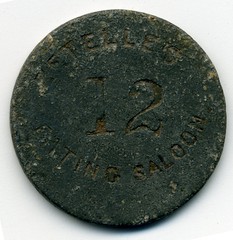 Here's what I brought to the dinner. I brought one of my latest acquisitions - a tin or lead token from
Zetelle's Eating Saloon from Richmond, Virginia. I brought it especially to show Dave as we are looking to see when it may have been
used. Zetelle was an interesting character. He emigrated from Corfu who ran a restaurant in downtown Richmond from sometime in the late
1850s through to at least July 1861 before returning to Europe during the Civil War. He returned to Richmond in 1865 and tried running a
restaurant again. It's a fascinating piece and worthy of some additional research.
Here's what I brought to the dinner. I brought one of my latest acquisitions - a tin or lead token from
Zetelle's Eating Saloon from Richmond, Virginia. I brought it especially to show Dave as we are looking to see when it may have been
used. Zetelle was an interesting character. He emigrated from Corfu who ran a restaurant in downtown Richmond from sometime in the late
1850s through to at least July 1861 before returning to Europe during the Civil War. He returned to Richmond in 1865 and tried running a
restaurant again. It's a fascinating piece and worthy of some additional research.
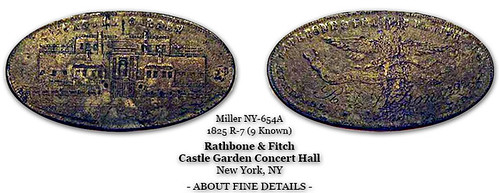
Aaron Packard displayed a very rare item among several new additions to his collection. He writes:
The U.S. retroceded Castle Clinton to New York City in 1822. The government of NYC leased the complex to Jonathan Rathbone and Francis Fitch, who opened the complex as an entertainment venue.
It's theorized that the Castle Garden tokens were actually subscriber admittance passes, engraved and struck by Richard Trested. Rulau reports that there are a total of 9 extant pieces. Eight are in silvered brass, and the ninth struck in lead. My particular specimen was issued to one "R.L. Wilson." ]
Over the next month or so, I anticipate publishing an article on the token and its history at www.novanumis.com.
The Big Nickel Transaction

At last month's meeting Gene and Dave made a great fuss over Wayne Herndon's buying price for pre-1960 nickels - 6 cents. Dave made up an invoice to Wayne, selling a single nickel - and declaring that it was owned jointly by him and Gene. Now Wayne had to pay each of them three cents.
Wayne kicked it up a notch by saying he'd have his bank issue and mail checks. It wouldn't cost Wayne anything, but his bank would have to shell out first class postage for each one. "Your bank isn’t going to like you," Gene said. "I don't much like them, either..." was Wayne's reply.
 Coincidentally, I'd found a pre-1960 in change that afternoon, and declared that I
was holding out for the long dollar - I wanted 7 cents. I didn't make a sale. But Dave and Gene had the evidence of their completed
transaction - six one-cent checks. Dave pointed out the "Hold until..." date, which was different for each check. Wayne said this
"would help with cash flow..."
Coincidentally, I'd found a pre-1960 in change that afternoon, and declared that I
was holding out for the long dollar - I wanted 7 cents. I didn't make a sale. But Dave and Gene had the evidence of their completed
transaction - six one-cent checks. Dave pointed out the "Hold until..." date, which was different for each check. Wayne said this
"would help with cash flow..."
A Chat With Ed Moy
I was landlocked for most of the dinner and didn't get to chat with many folks. I could only wave to Howard as he got up to leave. But
at the end of the evening as chairs opened up, Ed Moy moved down to talk with me and Roger Burdette. Ed and Roger knew each other well from
Roger's time on the Citizen's Coinage Advisory Committee. Topics included the High-Relief St. Gaudens restrike, the curved baseball
coin, digitizing U.S. Mint records, and Ed's various work projects. He recently moved back to the Washington, D.C. area, and we're
looking forward to having him at more meetings in the future.
I was able to chat a bit with Eric and Gene on the way out. It was another wonderful night of numismatic fellowship, and a great restaurant to boot (I had the salmon, and by skipping drinks and dessert got away with a very reasonable tab for such a fancy place). I'm already looking forward to next month.
To read the earlier E-Sylum article, see:
NOTES FROM E-SYLUM READERS: MARCH 15, 2015 : The Kings Private Roads Token
(www.coinbooks.org/esylum_v18n11a10.html)
DESIGNER JODY CLARK STRIKES FIRST NEW PORTRAIT COINS
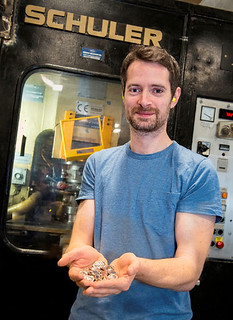 The Royal Mint this morning (17th April) began the minting presses which include the fifth or Clark portrait of HM Queen Elizabeth II. All
2015-dated coins from today, from the one penny up to the circulation £2 bi-metallic coins will depict the Queen as designed by Royal Mint
designer Jody Clark. Mr. Clark was the successful artist who was awarded the distinctive honor & distinction of having their effigy adorn
British coinage, replacing the fourth portrait designed by sculptor Ian Rank-Broadley whose depiction of Her Majesty was used on British
and commonwealth coinage since 1998.
The Royal Mint this morning (17th April) began the minting presses which include the fifth or Clark portrait of HM Queen Elizabeth II. All
2015-dated coins from today, from the one penny up to the circulation £2 bi-metallic coins will depict the Queen as designed by Royal Mint
designer Jody Clark. Mr. Clark was the successful artist who was awarded the distinctive honor & distinction of having their effigy adorn
British coinage, replacing the fourth portrait designed by sculptor Ian Rank-Broadley whose depiction of Her Majesty was used on British
and commonwealth coinage since 1998.
Jody Clark was offered the privilege of starting up the presses which will strike his own depiction of The Queen on all newly issued UK coins for general circulation from now on. Just 33 when his design was selected from a number of anonymous submissions to a design competition, Jody is the youngest of the five designers to have created the portraits of The Queen that have appeared on UK circulating coin during her 63 year reign and the first Royal Mint engraver to be chosen to create a definitive royal coinage portrait in over 100 years. His is only the fifth definitive portrait of The Queen to appear on our circulating coins since her accession to the throne in 1952, making it a very rare event indeed.
When the new coins begin to appear in the change of Britons, it will be the fourth portrait currently in circulation since the first portrait created by sculptor Mary Gillick. Her portrait was included only on pre-decimal coins and were eventually all removed from circulation after 1971 and during the program to reduce the diameter 10 and 5 pence coins which made the transition from 2 and 1 shilling coins in 1990 and 1992 respectively. Clark’s portrait joins those created in 1968, 1985 and 1998 and, together the coins that carry them tell the story of Her Majesty’s lifetime and paint a compelling picture of the story of her reign.
To read the complete article, see:
Jody Clark Starts
Presses to Strike Coins with Fifth Queen Elizabeth II Portrait
(http://news.coinupdate.com/jody-clark-starts-presses-to-strike-fifth-queen-elizabeth-ii-portrait-coins-4788/)
THE BOOK BAZARRE
DENMARK’S MARGRETHE II ON COINAGE
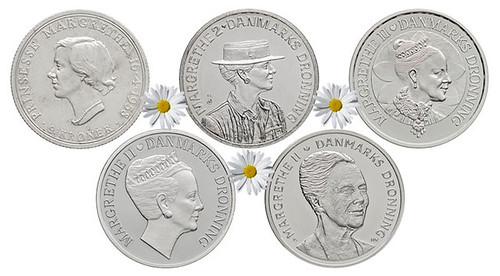
The centuries-long tradition of the Kingdom of Denmark celebrating Royal events & anniversaries with the issue of a commemorative coin continues this month, as 2015 ushers in celebrations for the 75th birthday of one of Europe’s longest serving heads of state, Queen Margrethe II of Denmark. The recent circulation coins of Denmark have undergone a lot of change, and the same goes for collector & commemorative issues. As a long-time collector myself, Danish coins have always been a favorite of mine to collect, mainly due to their variety and since their monetary reform in 1870, their frequency. Last year, the National Bank of Denmark made the disappointing announcement that due to the running costs of the Royal Danish Mint, which comes under their financial umbrella – and with the level of coinage anticipated in the coming years, they would be retiring the production facilities of the Royal Danish Mint from 2016 – and with it, more than five centuries of numismatic tradition. For this reason, the 2015 coin is especially poignant & relevant as it may likely be the last commemorative coin produced by the Royal Danish Mint before further production is tendered out to an exterior Mint facility.
If you are one of those collectors who can appreciate the fact that the Royal Danish Mint hasn’t “churned out” dozens of coins per year which in a real way, lessens their exclusivity or specialness associated with a commemorative coin, then Denmark is a country you should have or should be collecting. However, the fact that they haven’t bought in to producing many products may well be the reason the Bank has made the disappointing decision to fold up shop – thus ending a fine national tradition spanning more than 500 years.
As a tribute to some of my favorite coins which I’ve managed to acquire over the last couple of decades and in honor of the latest Danish silver Birthday crown, I’d like to focus on the previous birthday coins issued during Queen Margarethe II’s reign, beginning with the first one issued in 1958 celebrating her 18th birthday when her father King Frederik IX was the Danish monarch – to this coin issued on the 8th April which brings this specific topic to five in total. Previously, there have been coins marking the Queen’s 18th, (before her accession) her 50th, 60th and 70th birthdays. The stark differences which can be seen on all of these coins is a treat for admirers of diverse approach to design, a real delight to behold, all so different from one another and for so many reasons!
To read the complete article, see:
Denmark’s Margrethe II, A
Numismatic Evolution From Princess to Queen, 1958 – 2015
(http://news.coinupdate.com/denmarks-margrethe-ii-a-numismatic-evolution-from-princess-to-queen-4776/)
WHICH COUNTRY HAS THE LEAST SEXIST BANKNOTES?
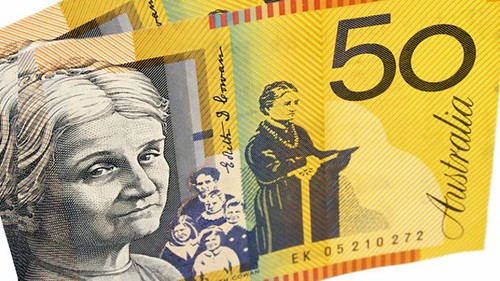
There are calls for the US and Canada to put a woman on a banknote. A similar campaign in the UK successfully convinced the Bank of England to put Jane Austen on the £10 note. But is just one woman per country enough?
American bills have portraits of the country's Founding Fathers and former presidents. Chinese notes have Mao Zedong and Indian ones have Mahatma Gandhi, but none of them feature any women. Many other currencies also stick to men, sometimes including a token woman or two.
Now there are calls for the US to put a female on the $20 bill. "The United States needs to show the world that we, too, recognise and value the contributions of women," says Susan Ades Stone, executive director of the campaign group Women On 20s.
"Our money says something about us and what we represent as a society. So if we're all about gender equality and diversity and inclusion, let's walk the walk."
The US currently has seven bills in circulation, all of which feature distinguished, deceased American statesmen. Women On 20s conducted an online poll and asked people to choose which of 15 historical female leaders they would most like to see on the note.
The candidates included civil rights activist Rosa Parks, birth control pioneer Margaret Sanger, suffragette Susan B Anthony and Harriet Tubman who escaped slavery and went on to lead other slaves to freedom.
Once the final poll closes, the group will petition President Obama to replace Andrew Jackson with the chosen woman.
Many wonder why Jackson - the seventh president of the US - hasn't been removed from the $20 bill already. He is especially unpopular with Native Americans due to his signing and enforcing the Indian Removal Act of 1830, which forced tribes off their land. Thousands of Native Americans died on the journey west - known as the Trail of Tears - from exposure, starvation and disease.
His controversial legacy is one of the reasons why Women On 20s chose to target this particular bill for change.
Meanwhile in Canada, more than 54,000 people have signed a petition to put a woman on a banknote there after the sole female to appear on the country's currency, Therese Casgrain, was replaced in 2011 by an icebreaker ship.
To read the complete article, see:
Which country has the least sexist banknotes?
(www.bbc.com/news/magazine-32204664)
HOW JANE AUSTEN GOT ON TO £10 NOTES
Until I saw reports about Winston Churchill being introduced as the new face of the five pound note, I’d never given bank notes much thought. But on reading that he’d be replacing the prison reformer Elizabeth Fry I realised this meant that, other than the Queen, there wouldn’t be any women on sterling at all.
It was only a few months since I’d set up the Women’s Room, which explores female representation, and I was acutely aware of how often women have been excised from our history in the past. I didn’t think there was any Machiavellian intent in the Bank of England’s decision but the oversight made me angry and I wanted to make a stand.
I started tweeting about it and set up a petition on Change.org. Then the media picked up on the story and I started getting requests to do press and TV interviews. A lawyer contacted me saying she thought the bank’s decision breached the Public Sector Equality Duty and put me in touch with a solicitor, Louise Whitfield, who helped me draft a letter of complaint. The Bank was surprisingly quick to respond, but its letter was very dismissive. It said women had been considered in the selection process, and seemed to imply that was enough.
Pre-internet, that might have been it – I can imagine a situation where I’d have been very disheartened by that response and not known what to do next. Instead, I was able to post a screenshot of the letter and publicly mock it. This added fuel to my campaign – as the letter was reposted across the internet, the number of petition signatories rocketed and we presented over 30,000 signatures to the bank.
 We made a request on Twitter for people to attend the presentation
dressed as historical female figures. I remember being really nervous because it could just have ended up being me dressed as Rosalind
Franklin, with my dog, but I needn’t have worried – the response was phenomenal. We had Mary Sewell, Emmeline Pankhurst, Amy Johnson,
George Eliot, Boudica – an amazing turnout.
We made a request on Twitter for people to attend the presentation
dressed as historical female figures. I remember being really nervous because it could just have ended up being me dressed as Rosalind
Franklin, with my dog, but I needn’t have worried – the response was phenomenal. We had Mary Sewell, Emmeline Pankhurst, Amy Johnson,
George Eliot, Boudica – an amazing turnout.
The Bank seemed reluctant to back down, and maintained there were no grounds for a legal challenge. Nevertheless, I set up a crowd-funding page to raise money to potentially take them to court and the response was incredible – within two weeks, we’d raised up to £13,000.
Then I had a request from the bank for a meeting. I think this coincided with Mark Carney taking over from Mervyn King as governor – it’s possible he came in on his first day and said, “I don’t want to be worrying about the bloody faces on bank notes. Get all this off my desk!”
I maintained a poker face when I was called back in and told Jane Austen would be the new face of the £10 note, but I was overjoyed.
To read the complete article, see:
How
social media helped me get Jane Austen on to £10 notes
(www.theguardian.com/lifeandstyle/2015/apr/11/how-social-media-helped-jane-austen-banknotes-caroline-criado-perez)
THE BOOK BAZARRE
DICK JOHNSON'S TAKE ON WOMEN ON MONEY
A woman on the $20 bill? I asked three of my female friends their opinions. Their response:
"Leave the twenty alone."
"I wouldn't want to see any of those women on our money."
"Is that the best they could come up with?" [in response to the four finalists suggested].
The women candidates listed in the news Item were all advocates of some movement. As such half of Americans would be against them because of their political stance.
If I had to suggest a woman it would be a generic mother -- honoring Mothers of America. This is an icon no male could match and everyone could venerate.
Recalling the fiasco of the Susan B. Anthony on the circulating dollar coin, the U.S. Treasury has learned a lesson. With portraits of bigger-than-life male celebrities from early American history, they have served their illustrative purpose well on our coins and currency, even if they are Dead Presidents or historic men.
Nine years ago I wrote an article on Future Coins. I predicted because of increasing economic factors we would eliminate lower value coins. Instead the Treasury would issue higher value ones, five, ten, twenty -- and sometime in the far distant future, the fifty dollar coin -- all for circulation. I tackled the problem of whose portrait should appear on these coins.
My suggestion was to keep the same portraits as on our present currency. Thus Jackson can mean $20 in everyone's mind whether coin or paper. That would eliminate such controversy as is presently raised on placing a woman on our currency.
No woman, it seems, would be able to appeal to all Americans. Existing portraits have a satisfactory record.
To read the earlier E-Sylum article, see: CAMPAIGN LOBBIES TO PUT A WOMAN ON THE TWENTY (www.coinbooks.org/esylum_v18n10a28.html)
THE PHANTOM SILVER DOLLARS OF 1895
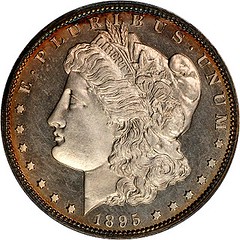 The Morgan dollar has long been one of the most popular American coin series, apparently second only to
the Lincoln cent in the number of people who collect it in some manner, and the 1895-P dollar has long been called “The King of Morgan
Dollars.”
The Morgan dollar has long been one of the most popular American coin series, apparently second only to
the Lincoln cent in the number of people who collect it in some manner, and the 1895-P dollar has long been called “The King of Morgan
Dollars.”
However, for an equally long time it has been one of the more frustrating series to the collector who seeks completeness in his sets, as no numismatist has ever been able to fill the 1895-P hole in his Whitman album or Capital plastic holder with a genuine business strike specimen, despite a reported mintage of exactly 12,000 coins.
Wealthy collectors have usually been able to fill that hole with one of the 880 Proofs struck in that year.
Though none was ever found, reference books continued to list the 12,000 pieces as having been struck, and collectors held out the hope that someday, somewhere one of them would turn up. Collectors remembered how the extremely rare 1903-O Morgan dollar, most of which had indeed disappeared in 1918, became much less rare in 1962 when several hundred thousand pieces were discovered in Treasury vaults, and various second or third hand reports about findings of so-called business strike 1895’s, invariably circulated Proofs, kept the myth alive.
Even now I hear the numismatic equivalents of “urban legends” about how supposedly the famous coin dealer B. Max Mehl kept an original bag of 1895-P dollars in his safe, or that the Las Vegas Mafia has two bags, or other such nonsense. Now, however, there is convincing evidence that the 12,000 business strikes reported for 1895 never existed, or at least that if 12,000 coins were released in 1895 they were actually dated 1894!
Q. David Bowers, in his monumental “Silver Dollars & Trade Dollars of the United States, An Encyclopedia,” presents an amazingly in-depth reference source of contemporary accounts of all U.S. dollars that could not be duplicated without a lifetime of research. While having the privilege to read this book in galley form, I noticed a comment from George W. Rice in an article from the June, 1898 Numismatist that I had not seen before, which stated “In 1895, Proofs only, numbering less than 1,000, were struck.”
This comment has generally been overlooked in the modern study of Morgan dollars, yet it clearly states that no business strikes were known to exist or had even been produced long before the 1918 melting occurred. Bowers also quotes Pennsylvania dealer, ANA Governor and for many years the ANA’s official counterfeit detector Charles Steigerwalt as writing in “The Curio” in December of 1898 that “Dollars of 1895 from the Philadelphia Mint are only found in the Proof sets.”
Henry T. Hettger has followed up on the questions raised in Bowers’ book with an article published in the May/June 1994 issue of Bowers and Merena’s “Rare Coin Review” that does prove to my satisfaction that the 1895 business strikes never existed.
To read the complete article, see:
Coin Profiles – The Phantom Silver
Dollars Of 1895 (www.coinweek.com/coins/coin-profiles/coin-profiles-the-phantom-silver-dollars-of-1895/)

THE RAND BROTHERS, BANK ROBBERS
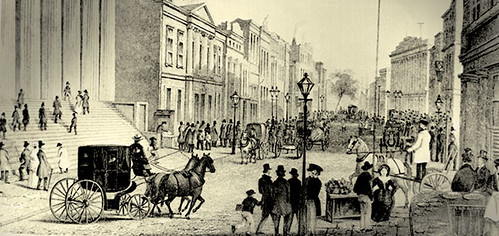
Hubert Walker of CoinWeek writes:
A couple weeks ago we excerpted the New York and VA bank robbery articles from The E-Sylum. A gentleman named Jerry Kuntz left comments that I thought I'd pass along.
"The 1852 Portsmouth robbery was the work of the Rand brothers, Abram, Richard, and most of all, John W. (Jack) Rand. In a nation that celebrates infamous criminals, the Rands have been sorely neglected. They were born in New Hampshire, but were longtime residents of Massachusetts–but ranged far and wide to commit robberies. Jack Rand voluntarily appeared and testified at the Portsmouth robbery trial of his brothers, knowing full well that doing so would incriminate himself. He even was grudgingly complimented in newspapers for giving himself up.
Jack Rand, it should be said, wasn’t very fearful of jail. He was convicted in October, 1852 and escaped from jail a couple of weeks later. It was a trick he repeated several times."
Jerry adds:
"I did make one error--brother Richard Rand had been implicated in a Quincy, Mass bank robbery in 1843 that John was convicted for; however, Richard was already dead by the time the Portsmouth bank robbery occurred. It was another brother, Oliver H. Rand, that was tried along with Abram Rand and John Rand.
"One other footnote: Oliver H. Rand, one of the brothers implicated in the Portsmouth bank robbery, was, at the time, the superintendent of construction of the Washington Monument. No surprise: he had to resign."
Yes, I'm annoyed every time I see references to American bank robberies originating with Western outlaws. There were many bank robberies before the 1860s--and many professional bank thieves."
To read the earlier E-Sylum articles, see:
NEW YORK'S FIRST BANK ROBBERY
(www.coinbooks.org/esylum_v18n12a32.html)
EARLY BANK ROBBERIES IN VIRGINIA (www.coinbooks.org/esylum_v18n13a32.html)
To read the earlier CoinWeek article, see:
Excerpts from
the E-Sylum: First American Bank Robberies – March 29, 2015
(www.coinweek.com/paper-money-2/paper-money-us/excerpts-from-the-e-sylum-first-american-bank-robberies-march-29-2015/)
SS CITY OF CAIRO COIN TREASURE SALVAGED

A British-led team has recovered a $50m (£34m; €47m) trove of silver coins that has lain on the seabed since the steamship carrying it from Bombay to England was sunk in 1942.
The SS City of Cairo was torpedoed 772km (480 miles) south of St Helena by a German U-boat and sank to 5,150m.
The 100 tonnes of coins, recovered in the deepest salvage operation in history, belonged to HM Treasury.
The silver rupees had been called in by London to help fund the war effort. But they never made it. The steamship's tall plume of smoke was spotted by a U-boat on 6 November 1942 and it was torpedoed.
Ten minutes later, amid efforts to abandon ship, the City of Cairo was hit with a second torpedo which sealed its fate.
The ship and its cargo was presumed lost until 2011, when a team led by British salvage expert John Kingsford located an unnatural object among the ridges and canyons of their South Atlantic search area.
The coins have now been melted down in the UK and sold, with the undisclosed sum divided between the treasury - which technically owns the coins - and the salvagers, who take a percentage of the sale.
The salvage was completed in September 2013, but DOS has only now been given permission by the Ministry of Transport to announce it.
Philip adds:
I guess they have all been melted - the Government is not in the Numismatic business, if we ignore the activities of the Royal Mint! Anyway, sorting and cleaning 8.5 million (my calculation) coins might not have been considered a viable proposition. My calculations suggest that $50 million dollars is the value at current silver prices ($16 per troy ounce) - back in 2013 the price was much higher although volatile, starting at about $50 per troy ounce but falling to $34 by the end of the year.
To read the complete article, see:
Record dive rescues $50m wartime silver from ocean floor
(www.bbc.com/news/world-africa-32316599)
On November 6, 1942, the steamer City of Cairo was on a desperate mission. From across the empire, Whitehall had called in Britain’s remaining riches to fund a war that still felt like a threat to its very existence.
Steaming across the Atlantic, midway through a perilous journey that began in India and took it around the Cape of Good Hope, the merchant ship was carrying 100 tonnes of silver rupees to pay for British food and arms. They were not to reach their destination.
Spotted by a U-boat and torpedoed, the City of Cairo was fatally holed. The U-boat captain surfaced amid the lifeboats and pointed them towards the nearest land: Saint Helena, 500 miles away, or, as far again but harder to miss, Namibia. “Goodnight,” he said, “and sorry for sinking you.”
To read the complete article, see:
Three-mile dive plucks £50m
in rupees from ship sunk by U-boat (www.thetimes.co.uk/tto/news/uk/article4411547.ece?shareToken=680d92d3bc9732f74a454b499c0595e0)
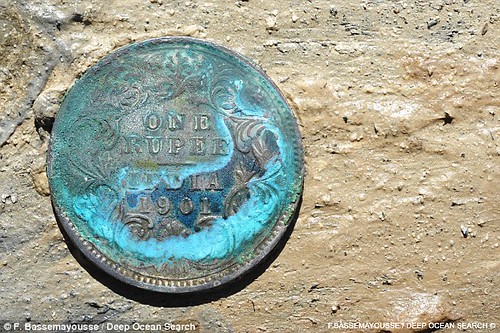

To read the complete article, see:
£34million hoard of silver coins sent to the bottom of the sea by the Nazis is discovered aboard sunken steamboat at a record depth of
17,000ft by British treasure hunters
(www.dailymail.co.uk/news/article-3039674/34million-hoard-silver-coins-sent-bottom-sea-Nazis-discovered-aboard-sunken-steamboat-record-depth-17-000ft-British-treasure-hunters.html)
To read the complete article, see:
Deep Ocean Search (www.deepoceansearch.com/City_Of_Cairo.htm)
WAS RUSSIAN WWII BULLION LOST IN RIVER?
Evidence has emerged of a wartime blunder that resulted in millions of pounds of Russian bullion, supposedly bound for America, being lost in the river Clyde. The gold and silver bars had been loaded in Murmansk onto a former Irish Sea ferry, converted into a battle cruiser with her superstructure stripped to take part in a dangerous Arctic convoy.
The bullion was to pay the Americans for arms shipped to Russia during one of the most crucial stages of the Second World War.
The former ferry, HMS Ulster Queen, arrived in Greenock in November 1942, after 13 days at sea and two ships sunk by German U-boats. But as a delicate operation began to transfer the cases of treasure onto a waiting boat, one slipped and fell into the muddy waters.
In fact, the incident has only come to light thanks to a secret diary kept by one of the Ulster Queen's engineers, and now revealed by his daughter for the first time in a new book.
Edinburgh man Leonard H. Thomas served on the Ulster Queen on four convoys to and from Murmansk and Archangel in Russia's extreme northwest.
Mr Thomas had got into the habit of keeping copious notes and sketches during his pre-war role as a crewman on the research ship RRS Discovery II in the Southern Ocean.
He had joined the Discovery as a 17-year-old in his native Portsmouth. He continued his writings on the Convoys - but aware that should any of his diaries be discovered he would be in serious trouble, he wrote in code and secreted them well.
Before he died in 2000, aged 88, he transcribed some of them into four A4 journals, which his daughter, Leona Thomas, has now edited into a book.
To read the complete article, see:
Was Soviet wartime fortune lost by accident in the Clyde? Evidence emerges that case of bullion fell into river as it was transferred
between ships during secret operation
(www.dailymail.co.uk/news/article-3039284/Was-fortune-wartime-Soviet-gold-lost-accident-Clyde-Evidence-emerges-case-bullion-fell-river-transferred-ships-secret-operation.html)

PUNIC EMPIRE COIN AMONG OLDEST DISCOVERED IN BRITAIN
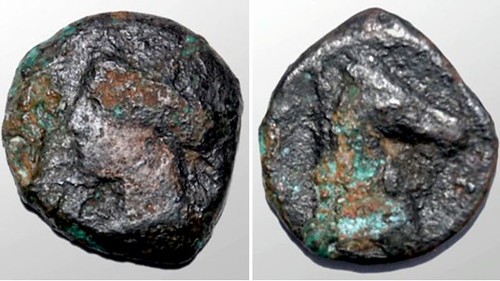
A 2,300-year-old coin found after flooding along the River Avon near Bath has revealed details of early maritime activity up the Bristol Channel.
The 20mm coin was spotted in receding floodwaters in 2012, but the owner kept the details private until now.
It has been verified by the British Museum and is understood to be a Carthaginian coin, minted around Sardinia in 300-264 BC.
Several similar examples have been recorded but only from the coastline.
On one side of the coin is an image of Tanit - a Punic and Phoenician goddess - and on the reverse is a horse's head.
Dr Sam Moorhead, who recorded it for the British Museum, said it could have been struck at one of several mints in the Punic Empire, including Carthage and cities in Sardinia.
"It is certainly one of the earliest coins found in Britain," he said, adding other examples had been found from Cornwall, around the south coast to Kent, and up the east coast to Lincolnshire.
To read the complete article, see:
Ancient coin suggests early activity on Bristol Channel
(www.bbc.com/news/uk-england-bristol-32289791)
A HOARD FOUND IN POLAND
Gosia Fort writes:
This article is in Polish but it says that a forester found two pots with more than 6,000 coins. They are mostly silver denarii (?) and Prague grosz (?) from 1516-1612 and he gave it all to the Archeological Museum in Swidnica.
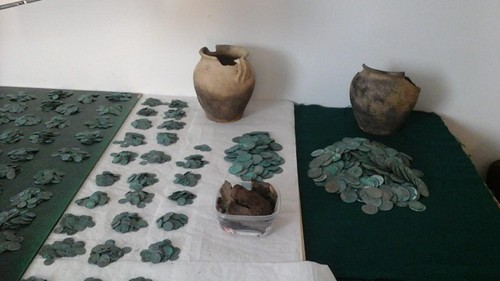
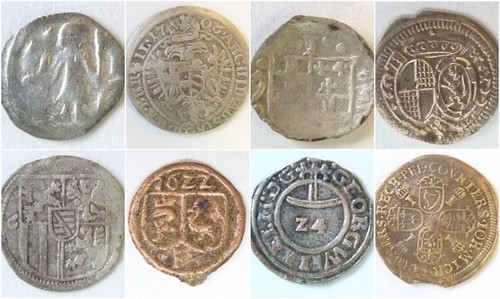
To read the complete article, see:
Leśniczy znalazł
skarb. Ponad 6 tysięcy srebrnych monet. Wszystko oddał do muzeum
(www.tvn24.pl/poznan,43/lesniczy-znalazl-skarb-z-ponad-6-tys-srebrnych-monet,533312.html)
COCOS ISLAND TREASURE A HOAX
On March 10, 2015, the online newspaper ‘World News Daily Report’ announced that an amazing 200 million dollar cache had been found... A photo shows a gold Madonna that is said to have come from the Cathedral of Lima – estimated metal value: more than 1.4 million dollars.
Numismatists were as keen as mustard and the experts in several treasure hunter forums expressed both their envy of the lucky rangers and their wish that the latter would be allowed to keep a decent finder’s reward at least.
Only a few days later, a number of media proved that report to be a hoax. Some of the images originated from the image hosting service Flickr and official institutions in Costa Rica knew nothing about any treasure.
As a matter of fact, the site ‘World News Daily Report’ is specialized in canards and, as the disclaimer states, it assumes ‘…all responsibility for the satirical nature of its articles and for the fictional nature of their content. All characters … are entirely fictional and any resemblance between them and any persons, living, dead, or undead is purely a miracle.’
Until Björn's article I hadn't noticed any numismatic publications discussing this, even as a hoax. Thanks! -Editor
To read the complete article, see:
News from Stevenson’s Treasure Island?
(http://coinsweekly.com/en/News/4?&id=3368)
To read the earlier E-Sylum article, see:
COCOS ISLAND TREASURE FOUND BY PARK RANGERS
(www.coinbooks.org/esylum_v18n11a22.html)
MEDIOCRITY AND GREATNESS IN NUMISMATICS
This month for the Q&A I had the pleasure of chatting with my friend Mark Van Winkle. Mark has cataloged many of the greatest rarities in numismatics in his job as chief cataloger at Heritage Auctions, but he’s also passionate about the arts, specifically opera.
During our conversation I asked him, “What can the opera teach someone about collecting coins?”
While I’ve never been much of an opera fan, I’m always curious how people find connections with the various passions in their lives, and how these connections enhance things.
Mark shared this story: In the 19th century, there were two prominent German operatic composers, Giacomo Meyerbeer and Richard Wagner. Meyerbeer was popular during his lifetime, but is little remembered today while Wagner is undoubtedly even more popular today than during his lifetime.
Why is one remembered and the other all but forgotten?
The answer is the difference between good and great. In U.S. numismatics, who is better remembered a hundred years after his death: Charles Barber or Augustus Saint-Gaudens? Obviously, Saint-Gaudens. Although Charles Barber created serviceable, traditional neoclassical designs that could be struck with one blow from a steam press, Saint-Gaudens adapted the three-dimensionality of sculpture to coin designs, something no one before (or arguably since) had done.
His coins were certainly a challenge to produce, but the results were magnificent. Greatness is remembered, while mediocrity is relegated to history’s dust-bin.
To read the complete article, see:
WHAT OPERA CAN TEACH US ABOUT COLLECTING (AND THE
DIFFERENCE BETWEEN GOOD AND GREAT) (www.coinworld.com/voices/steve-roach/2015/04/what_opera_can_teach.html)
FEATURED WEB PAGE: MARK R. SHENKMAN COLLECTION
This week's Featured Web Page is suggested by John and Nancy Wilson - the Mark R. Shenkman collection exhibit at New York's Museum of American Finance. Thanks!This exhibit features approximately 250 notes spanning from the Colonial era to the present day and allows visitors to explore them in an interactive environment. Highlights include rare examples of currency bearing the signatures of signers of the US Constitution and Declaration of Independence; a complete set of notes from the Educational Series of 1896, renowned for being the most beautiful paper money in American history; and rare examples of high denomination notes including $5,000 and $10,000 bills
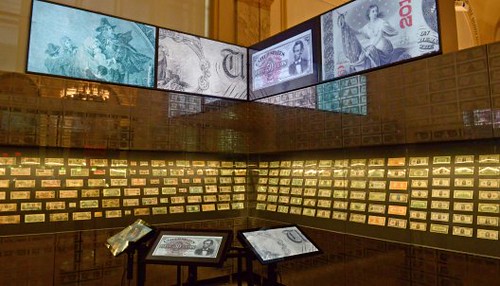
www.moaf.org/exhibits/america_circulation/index

